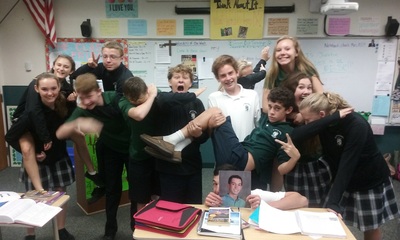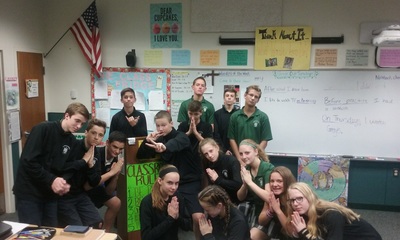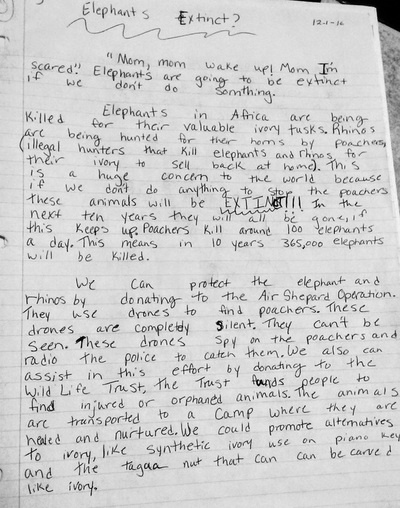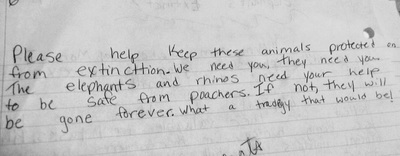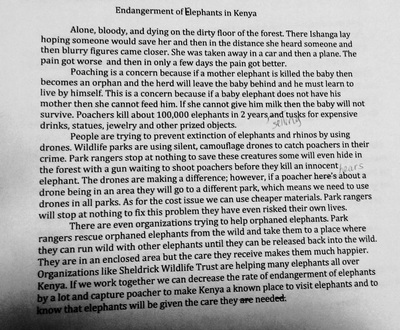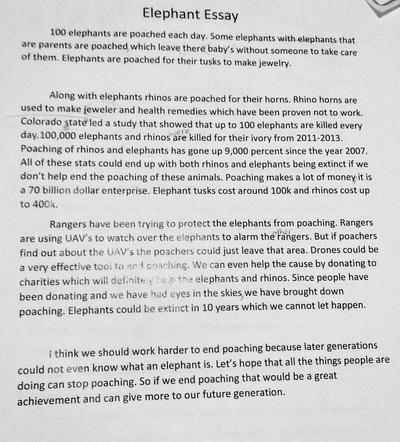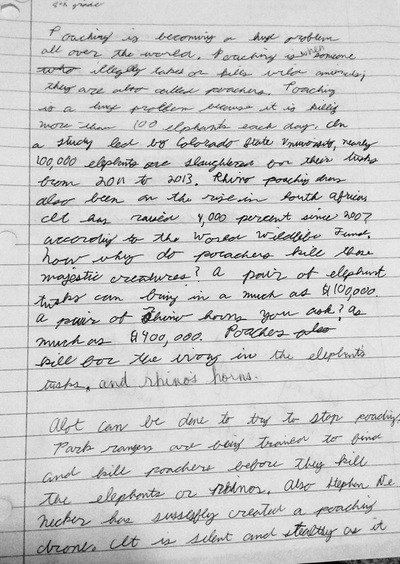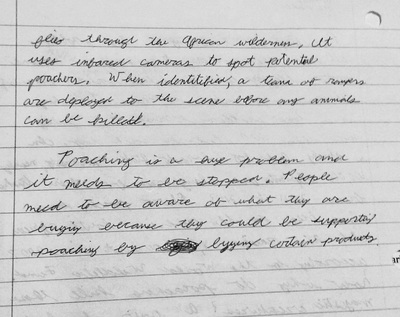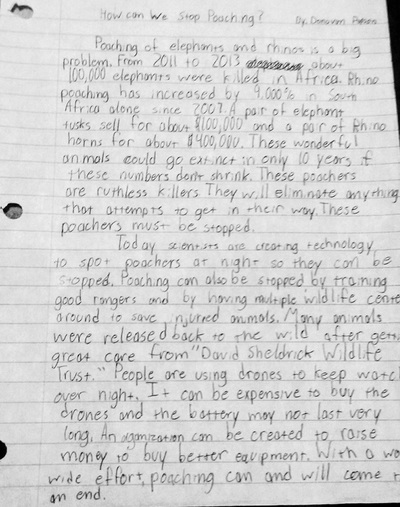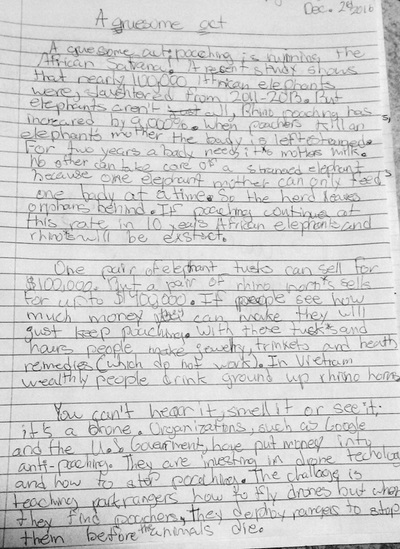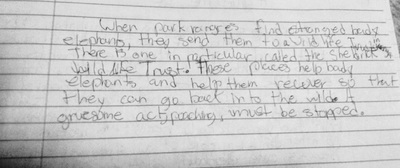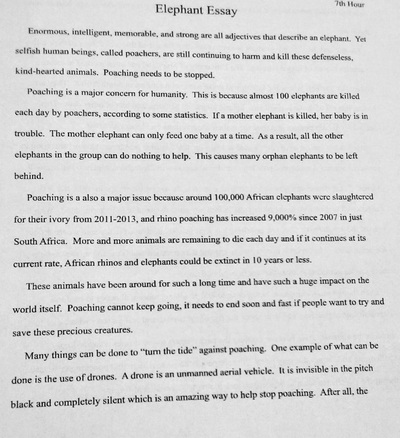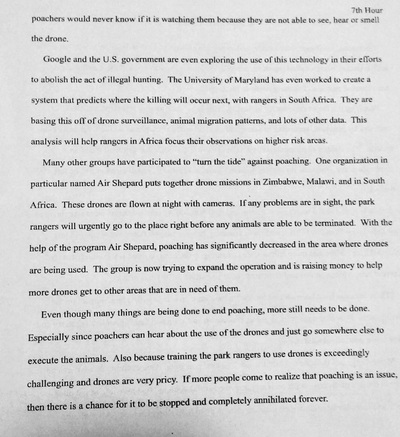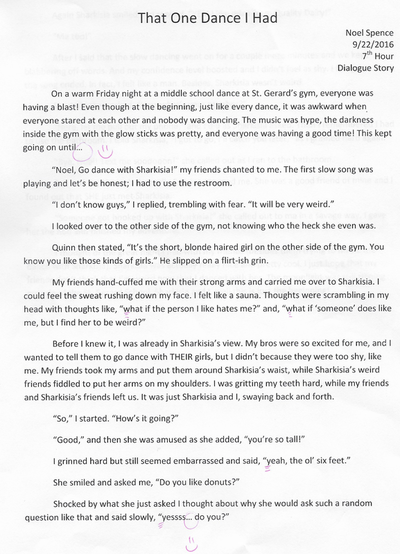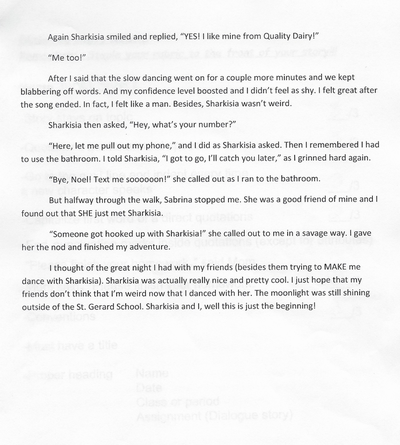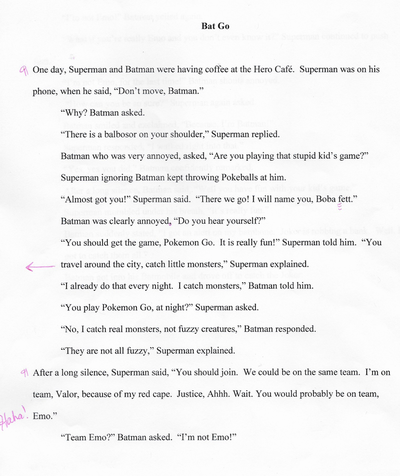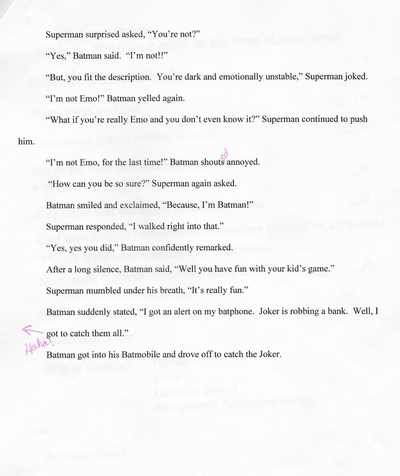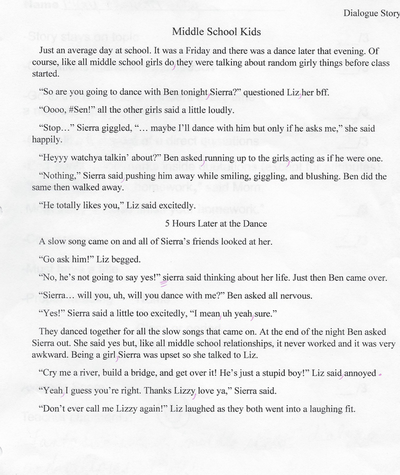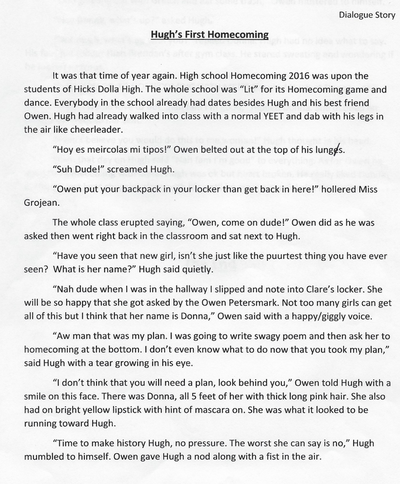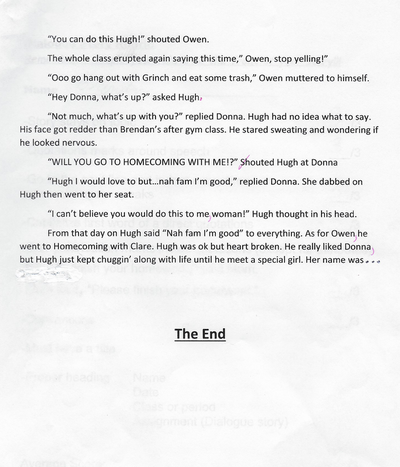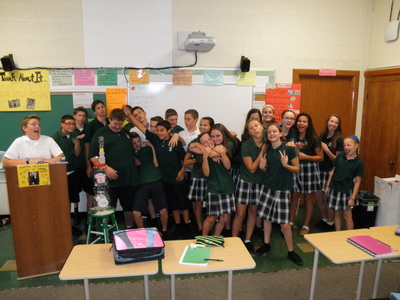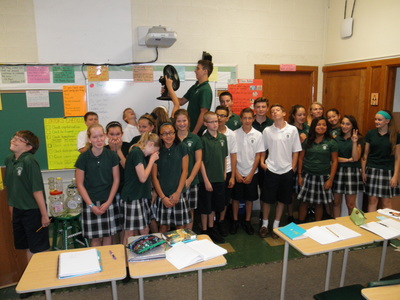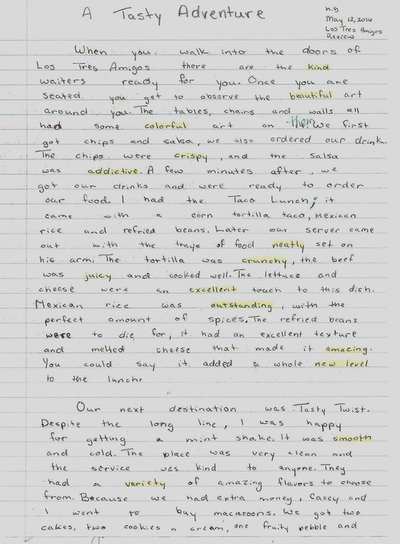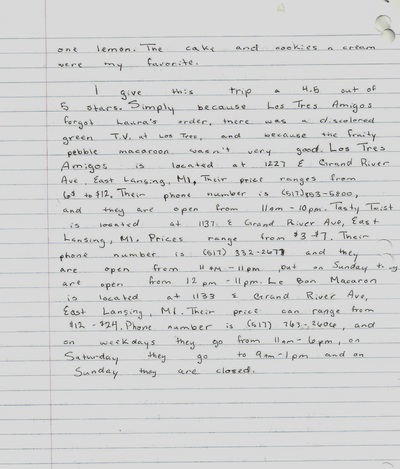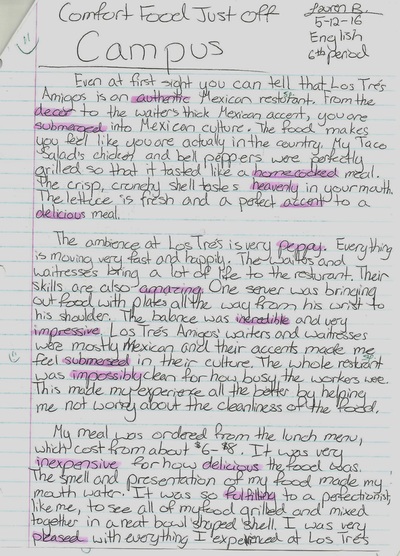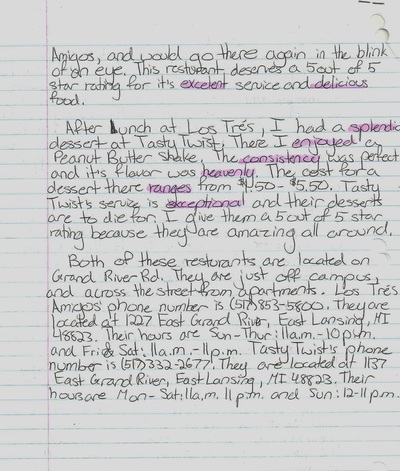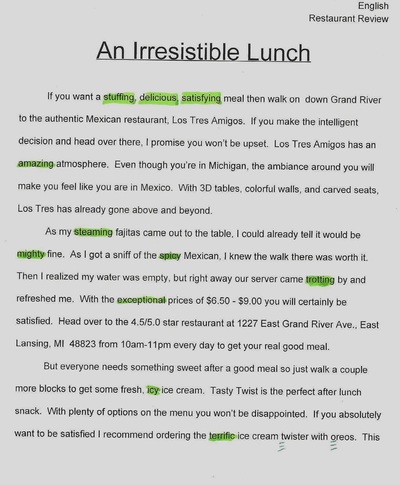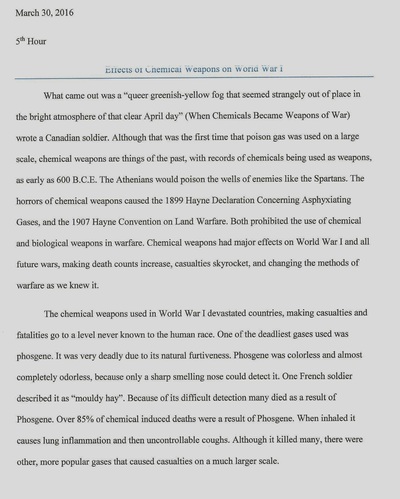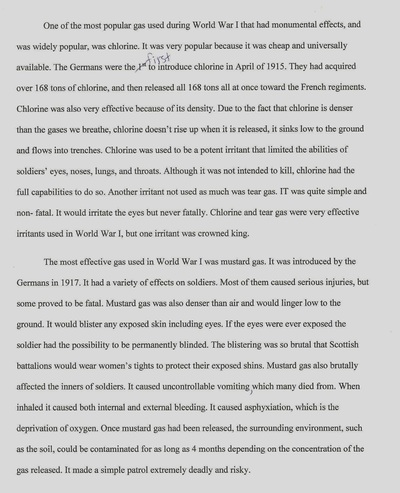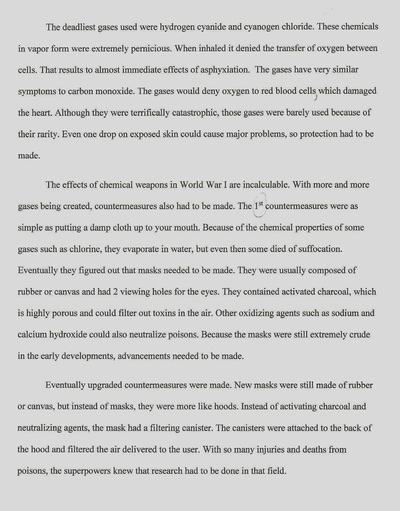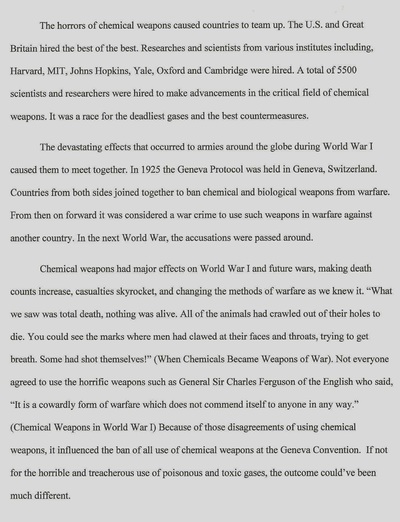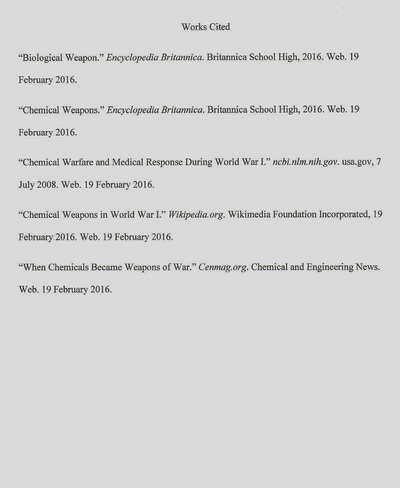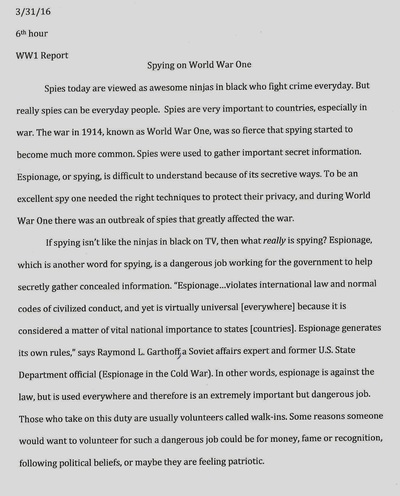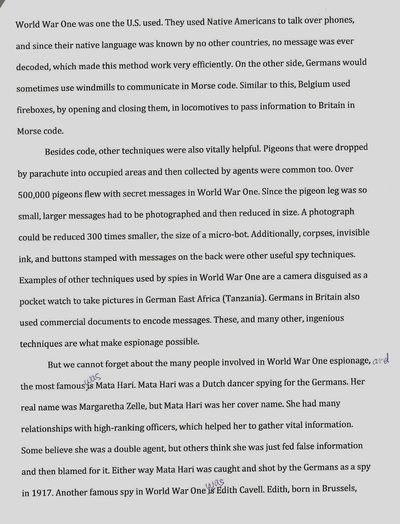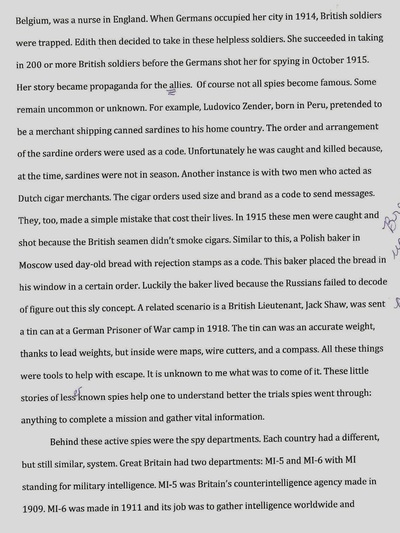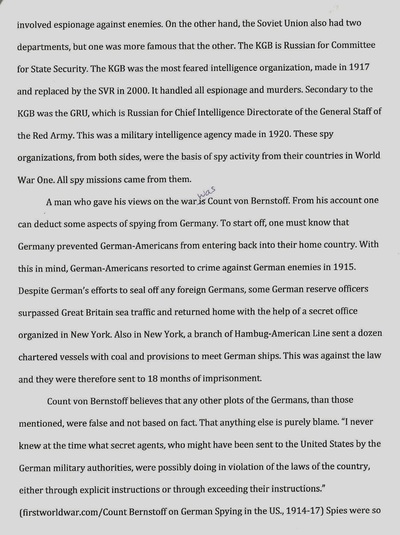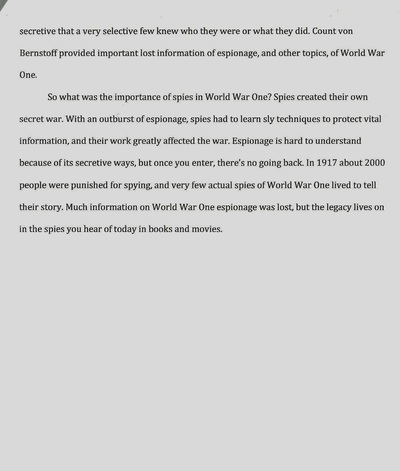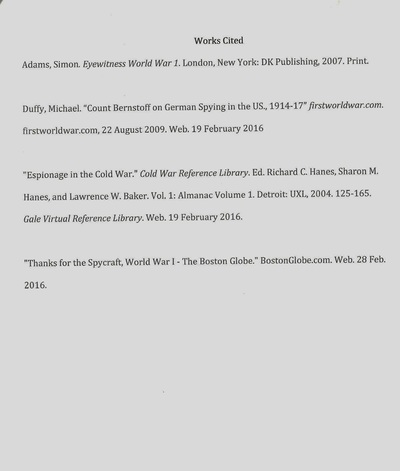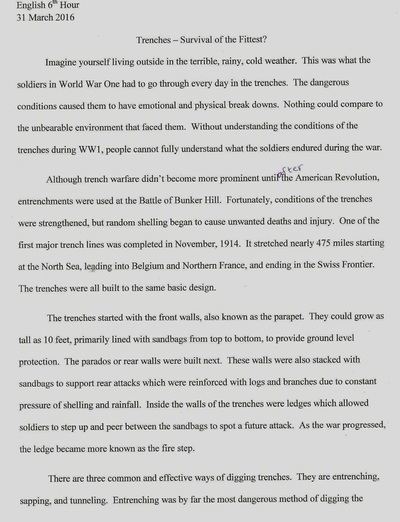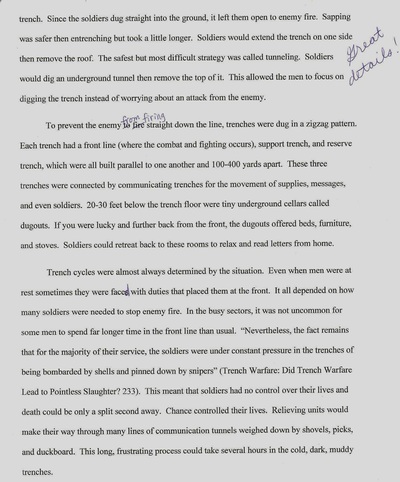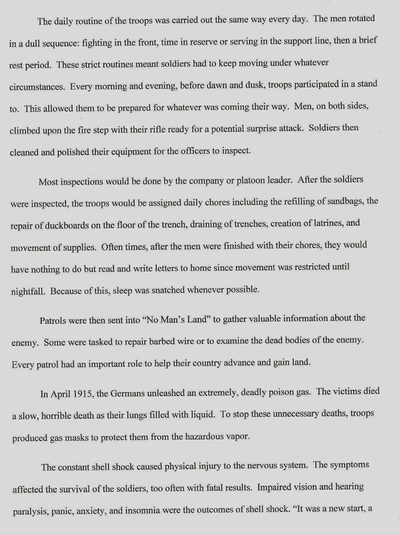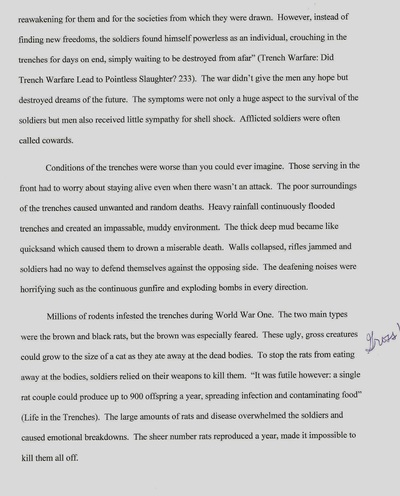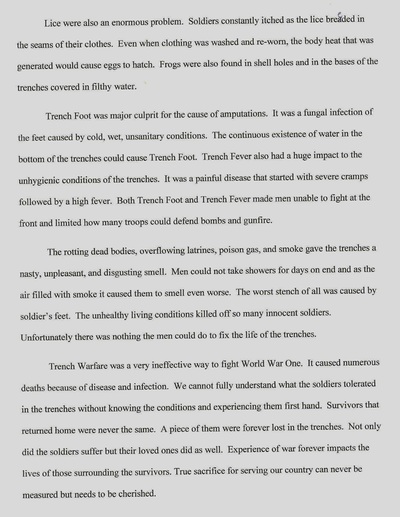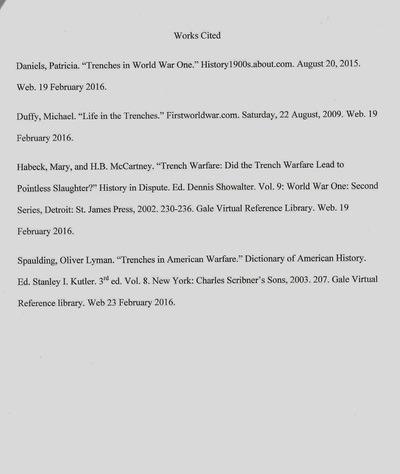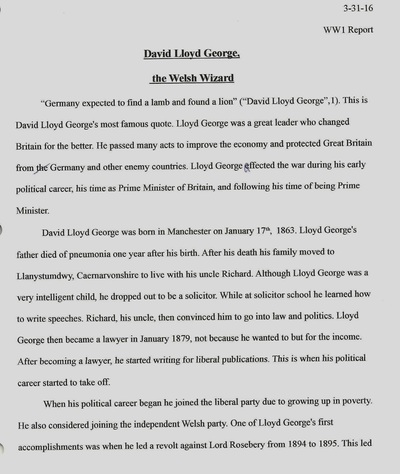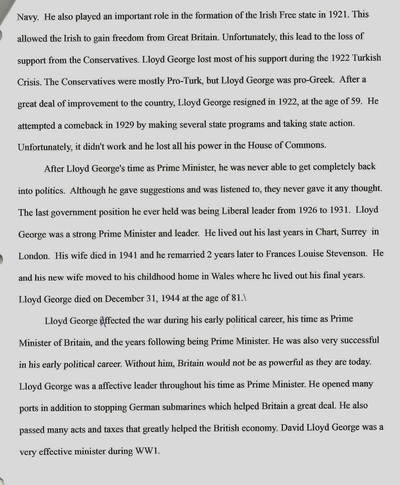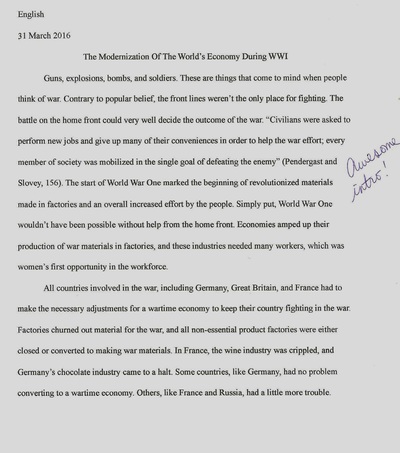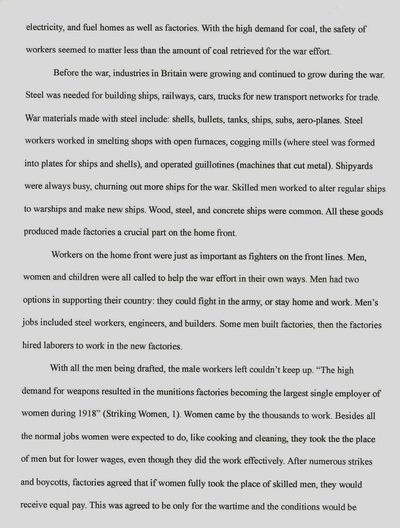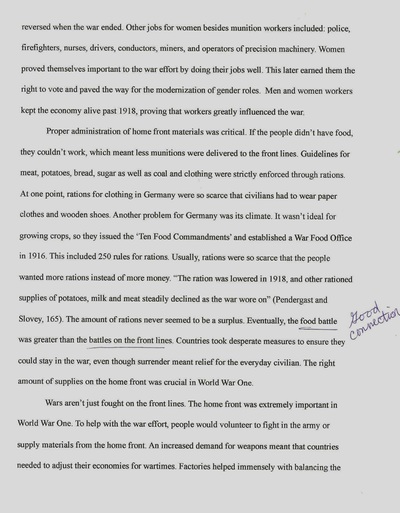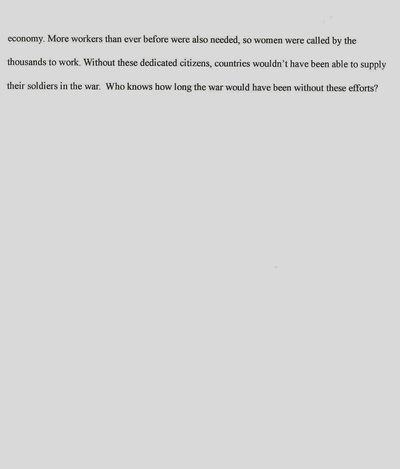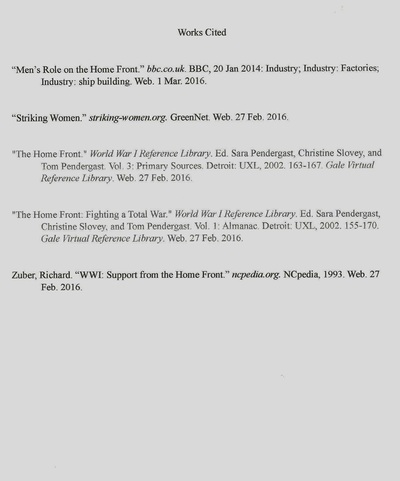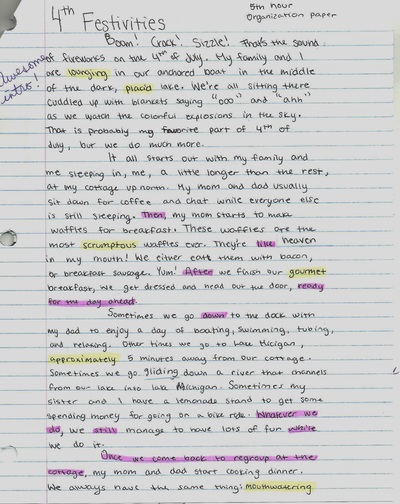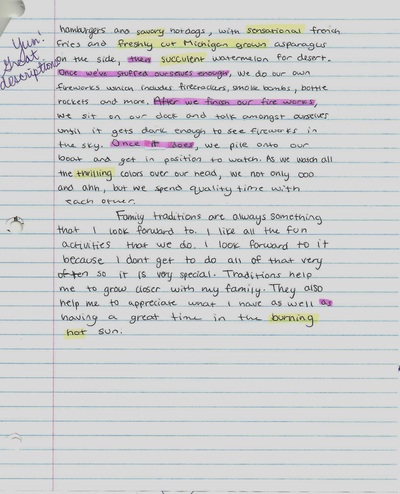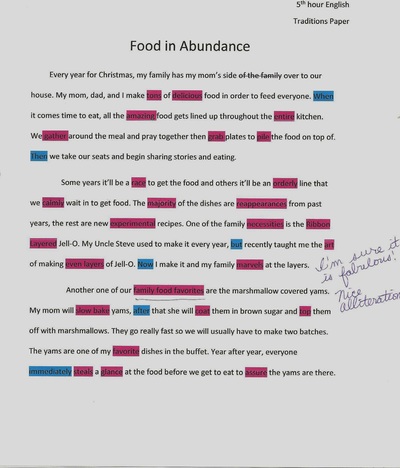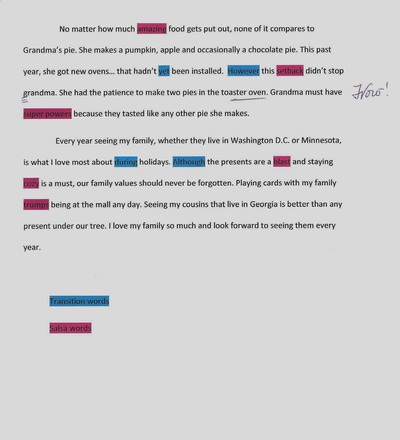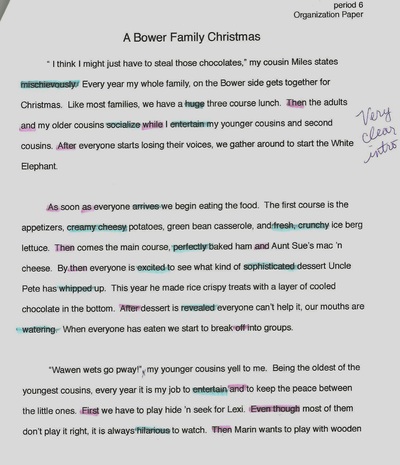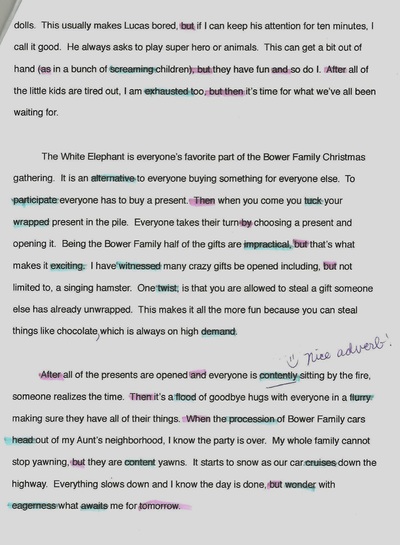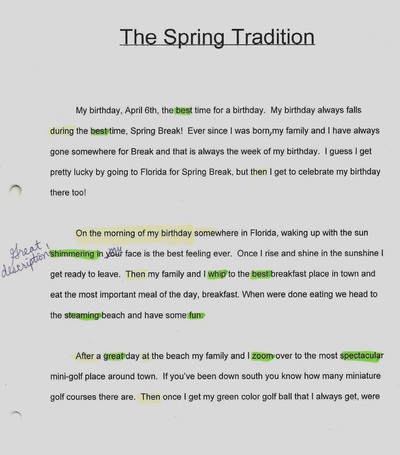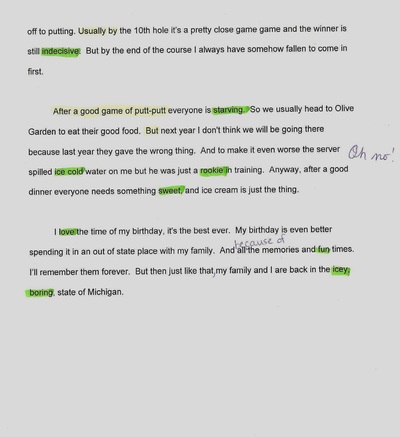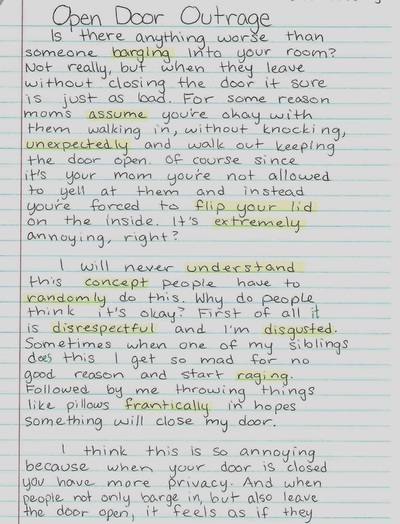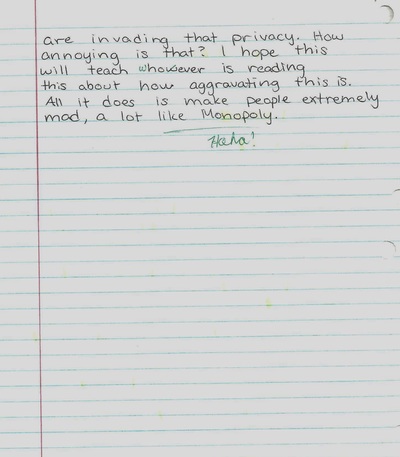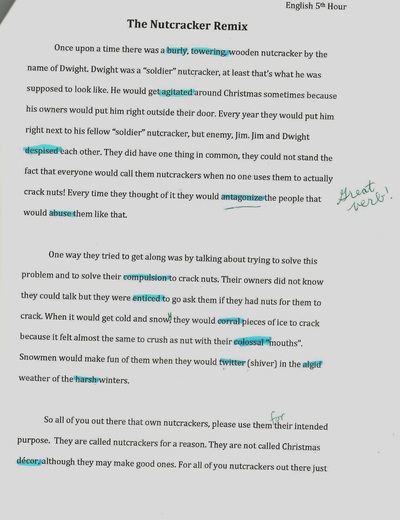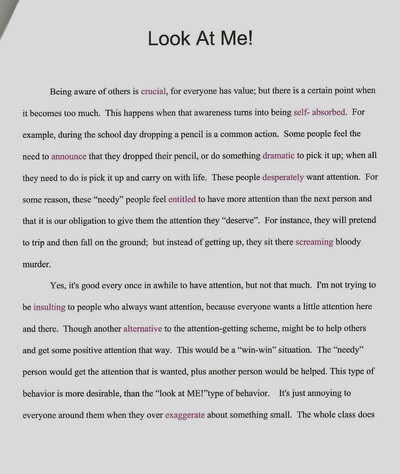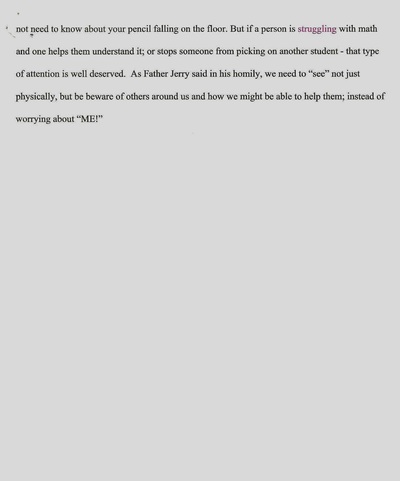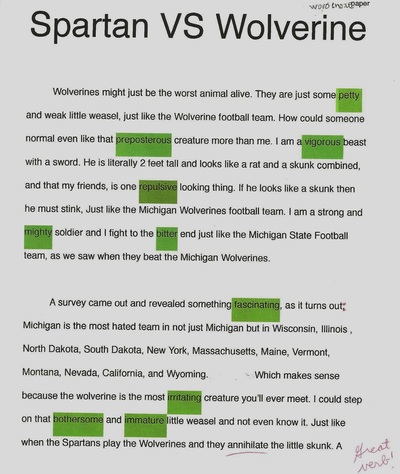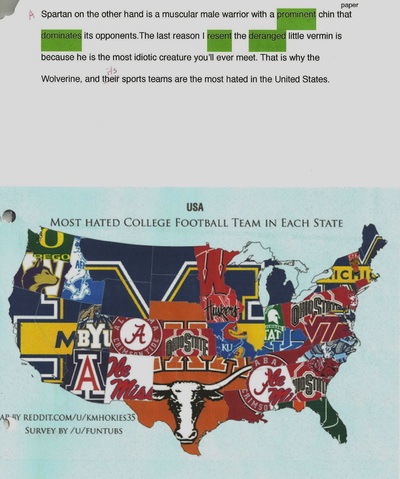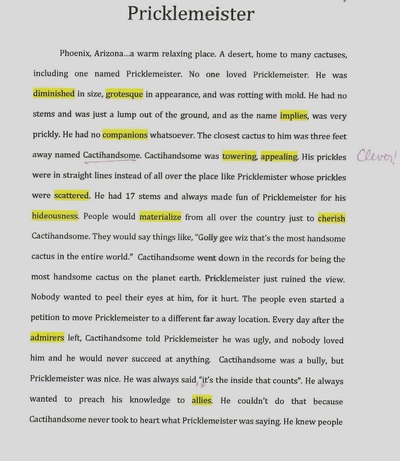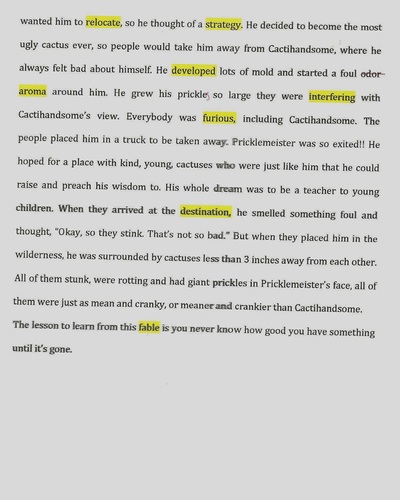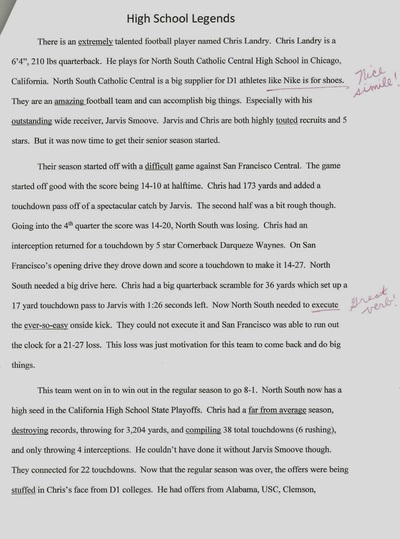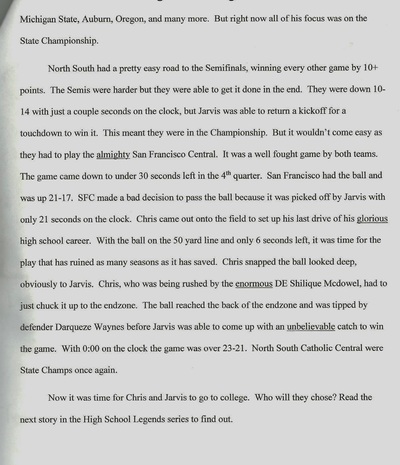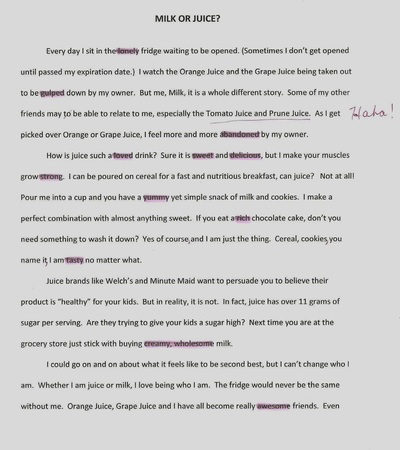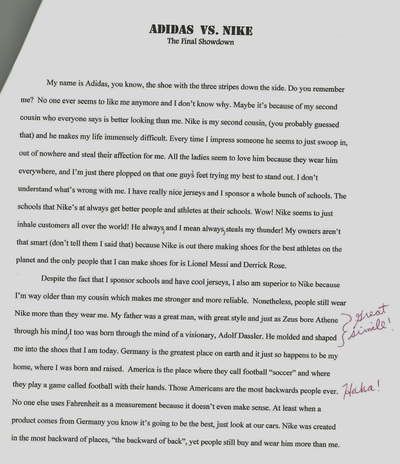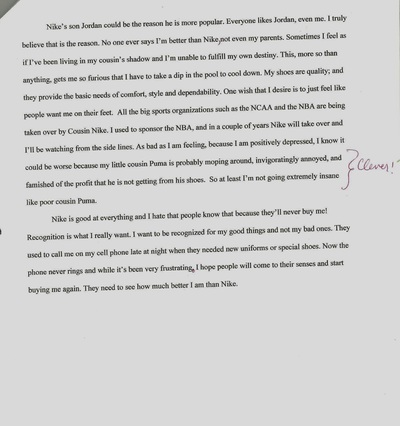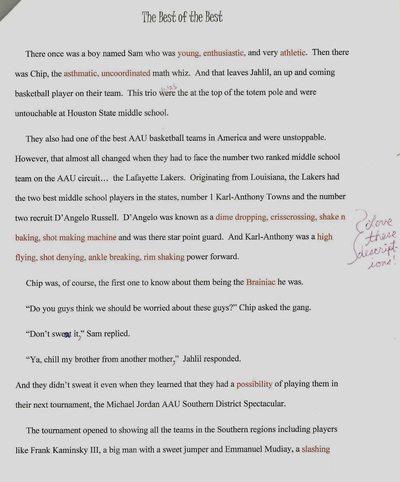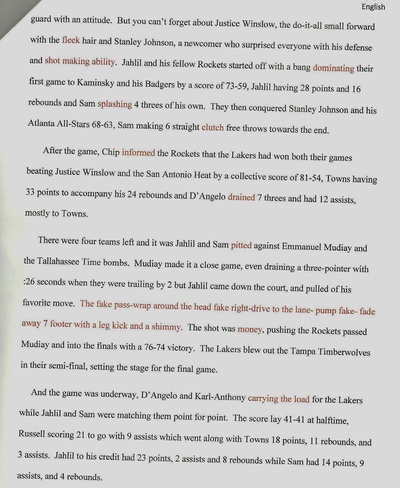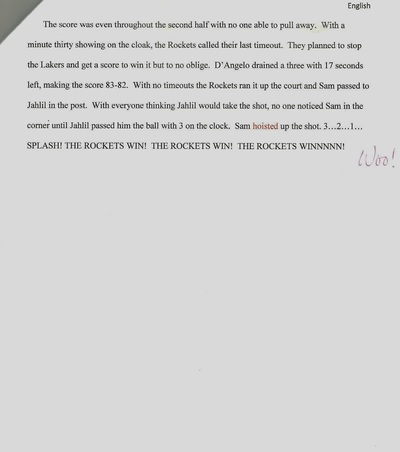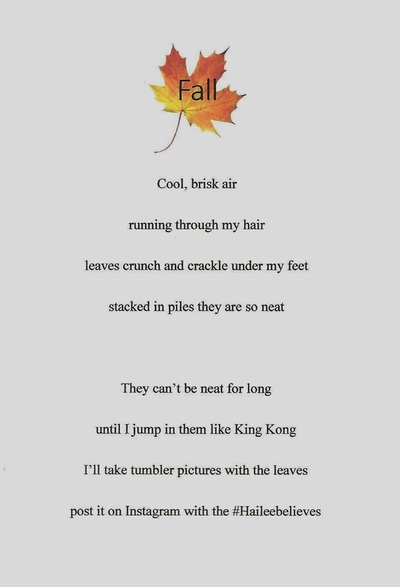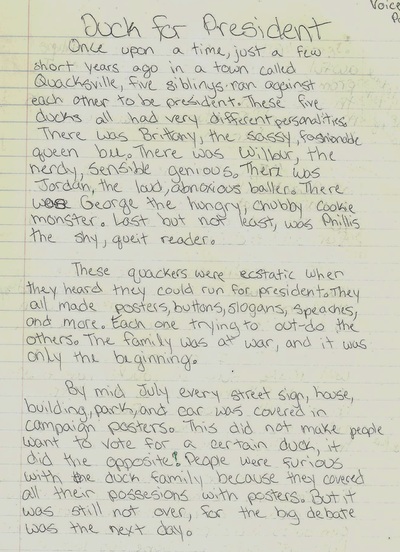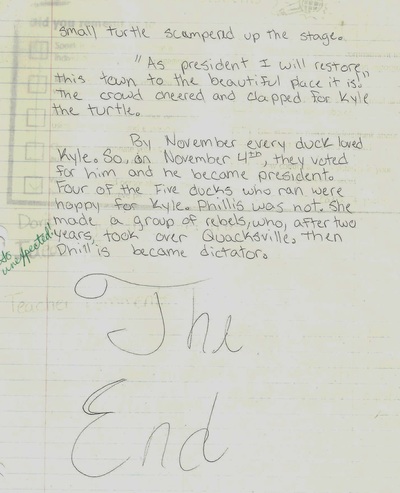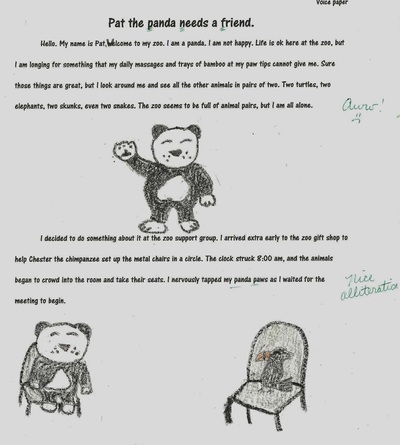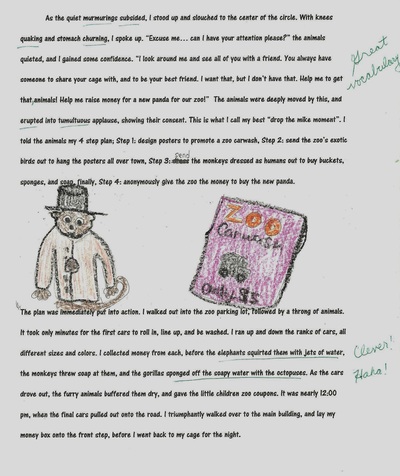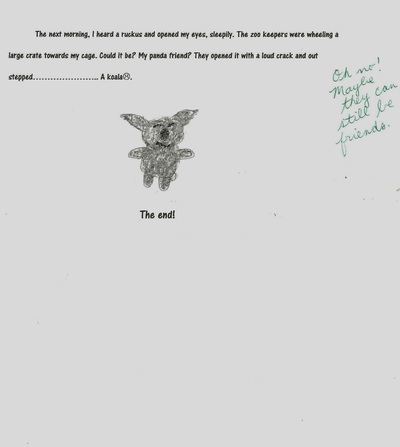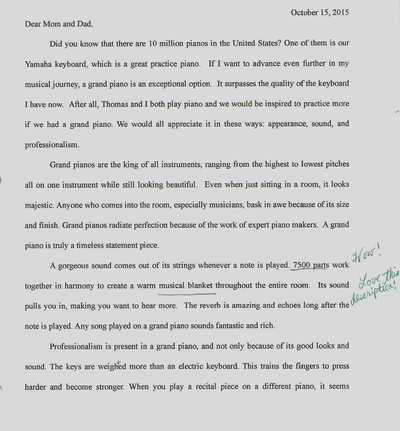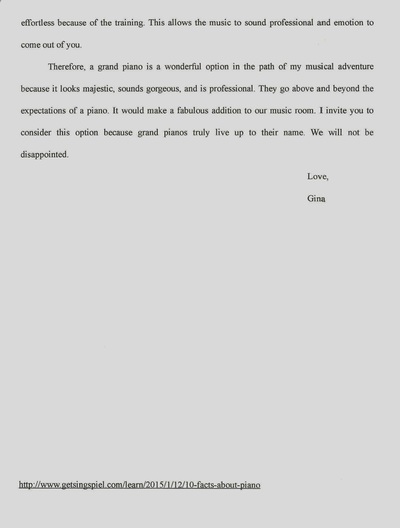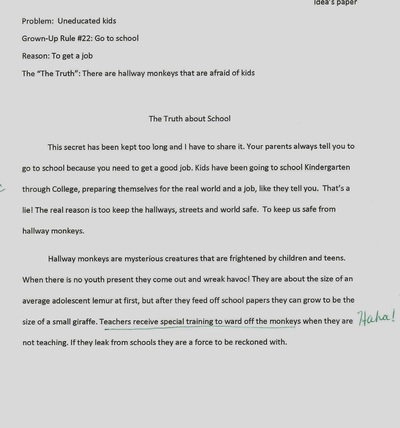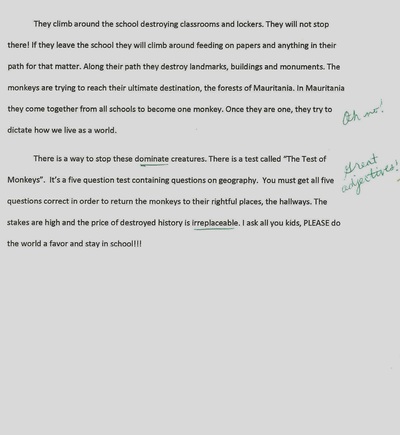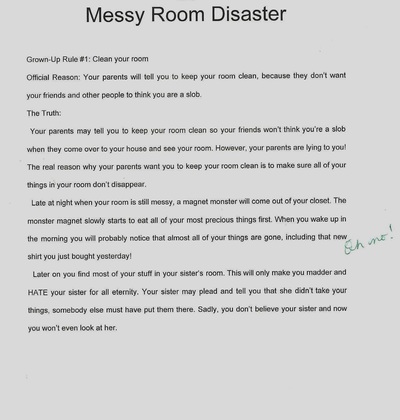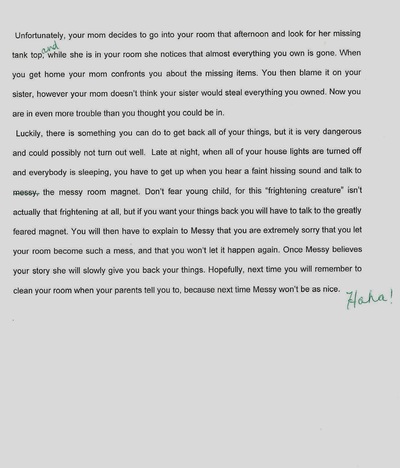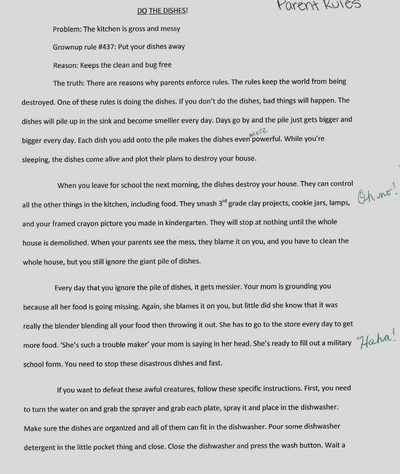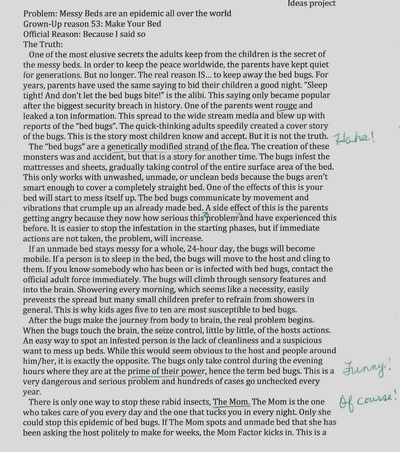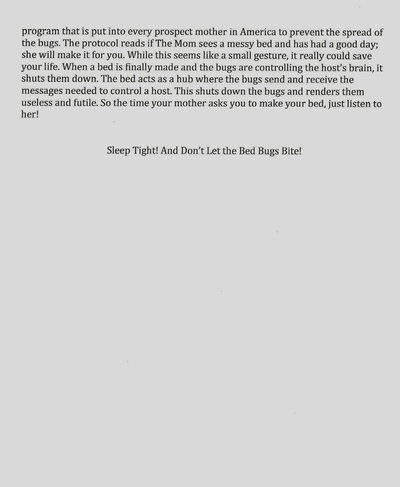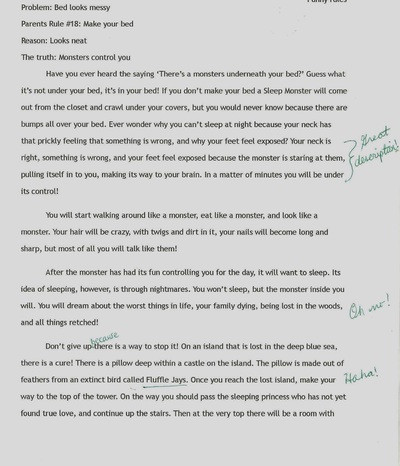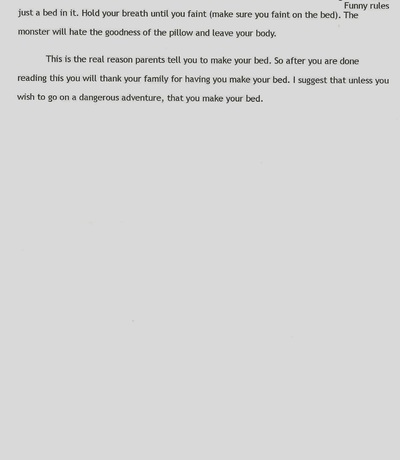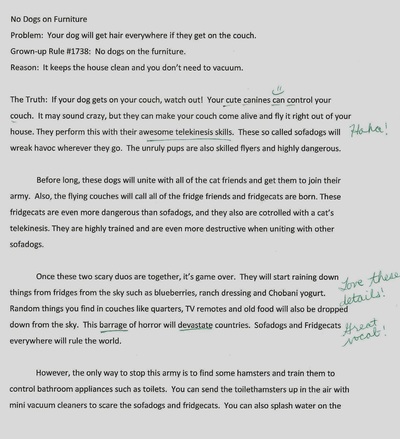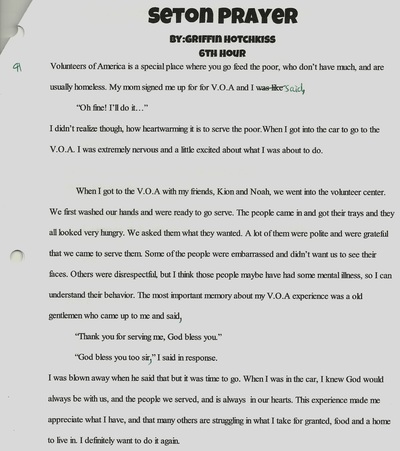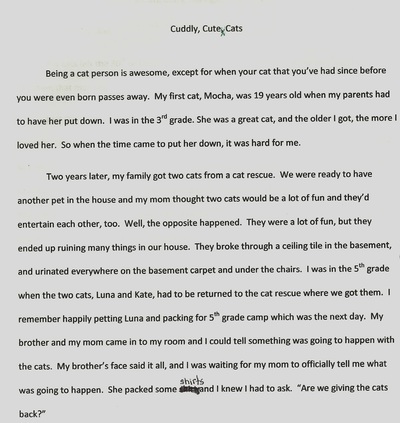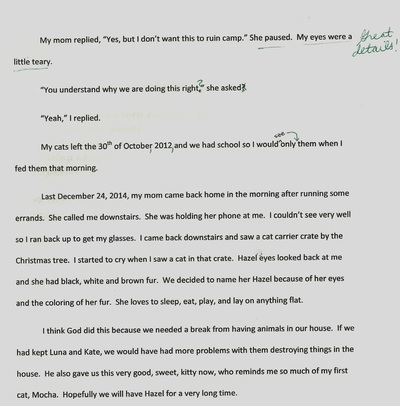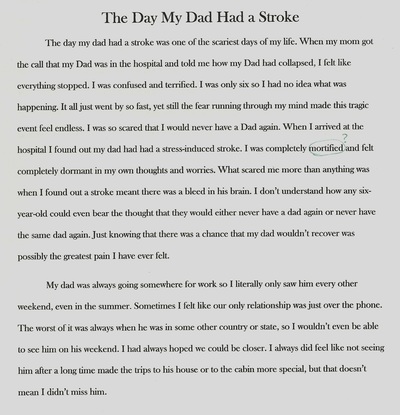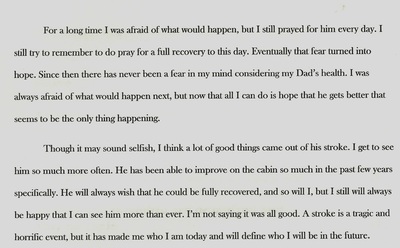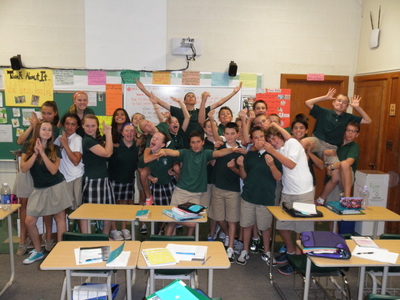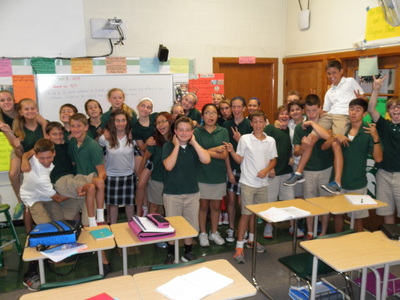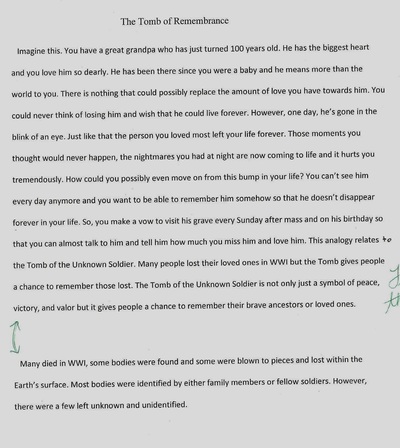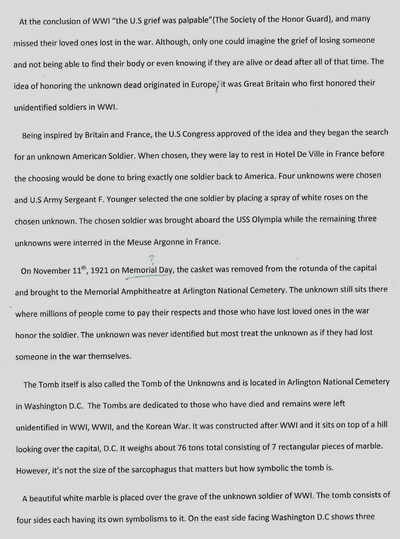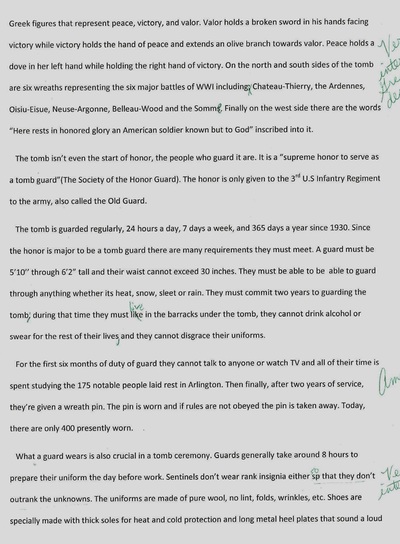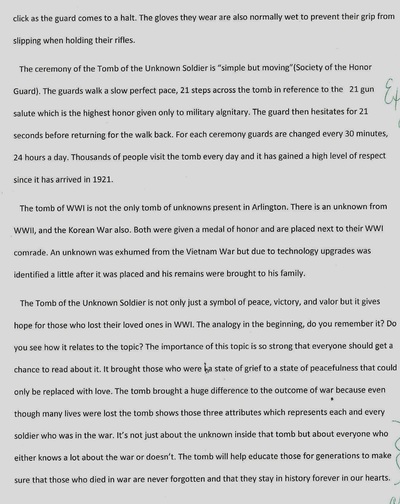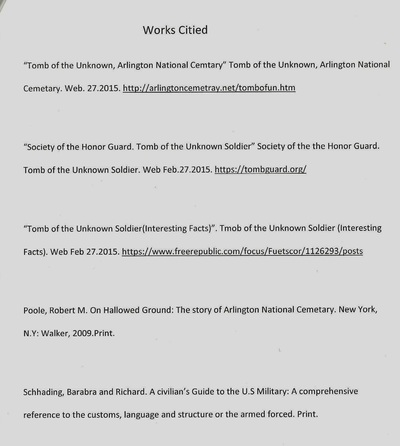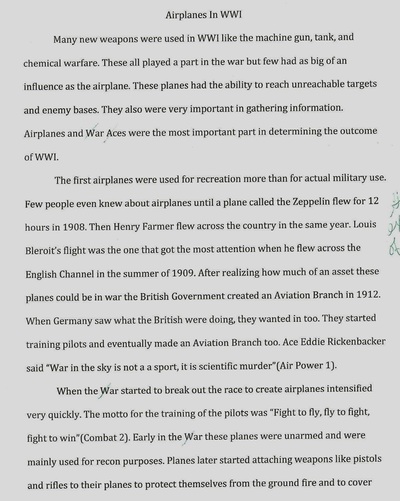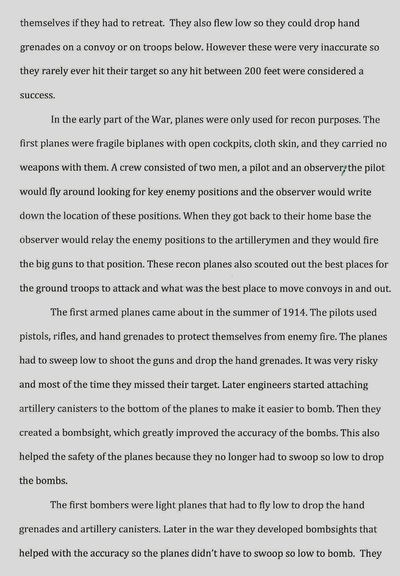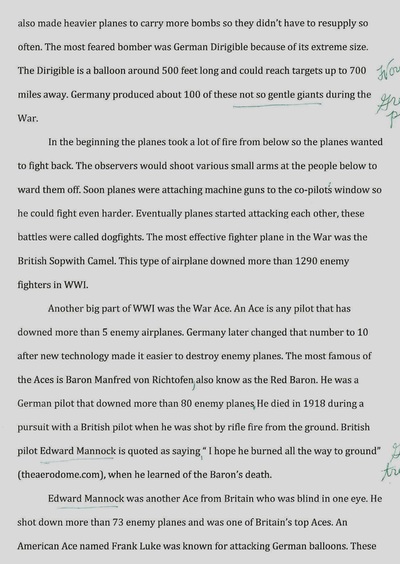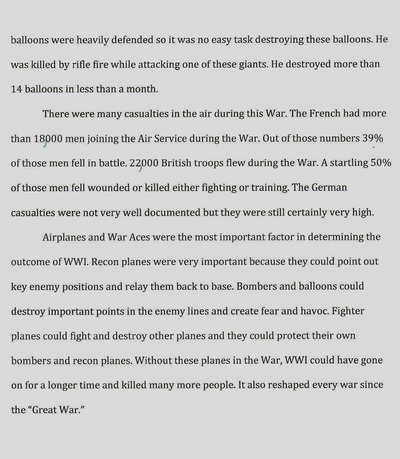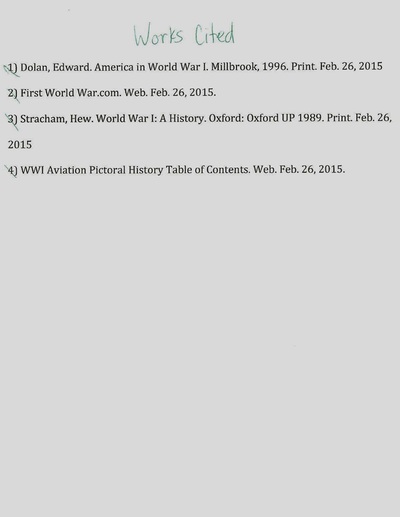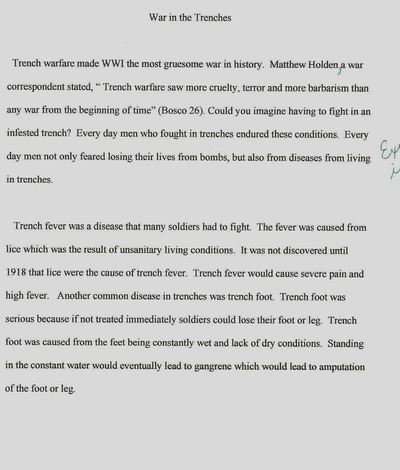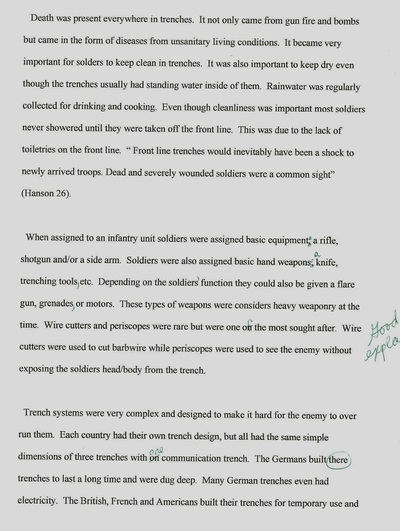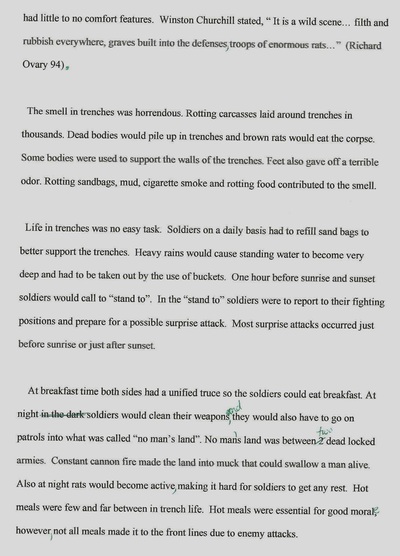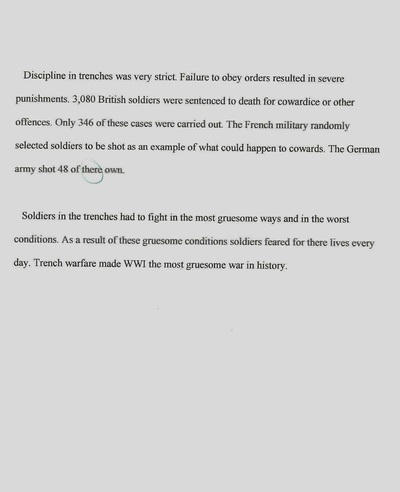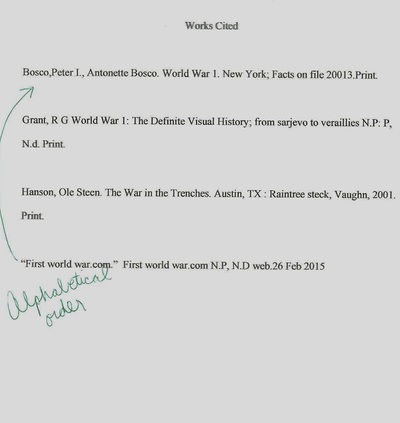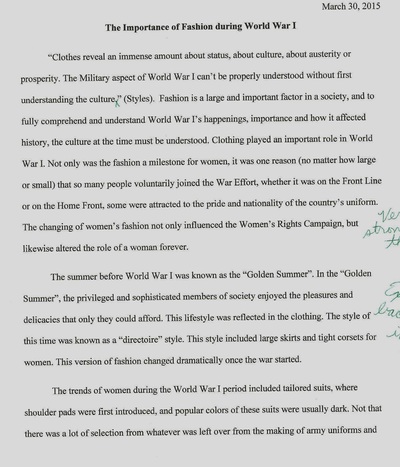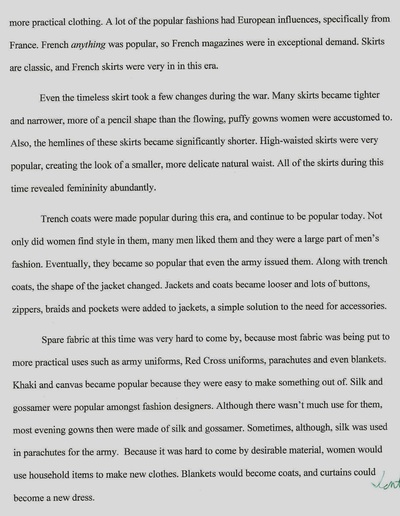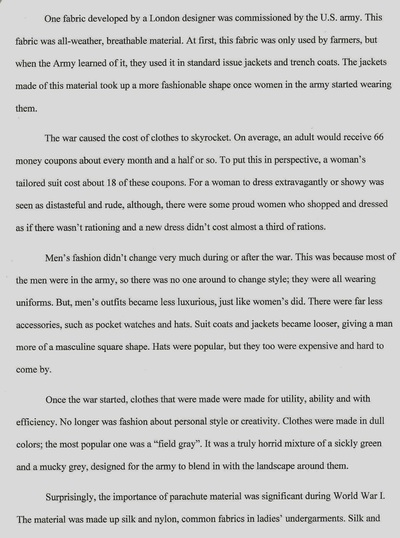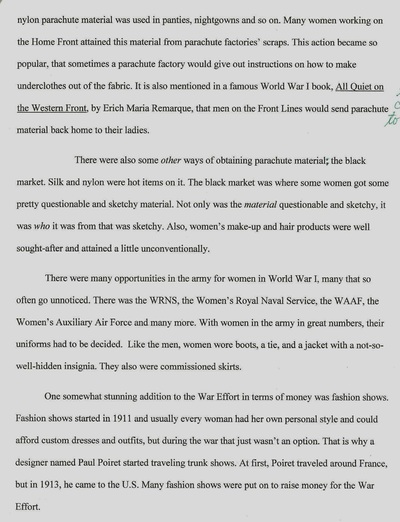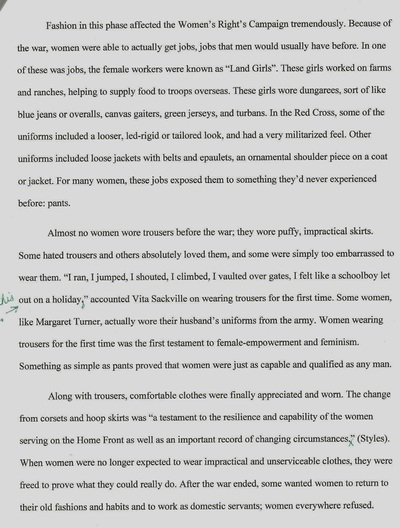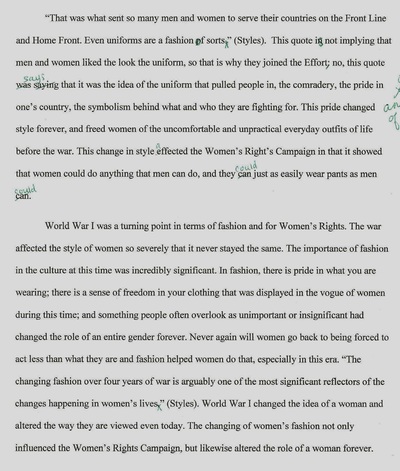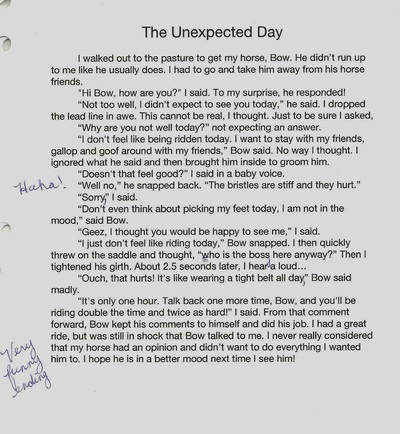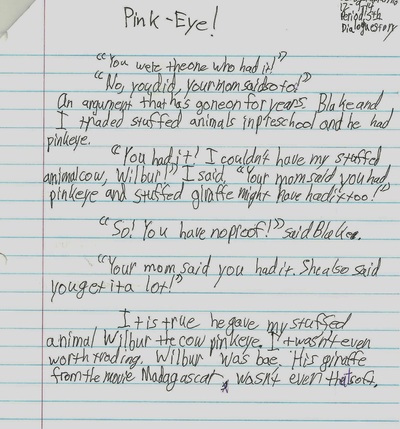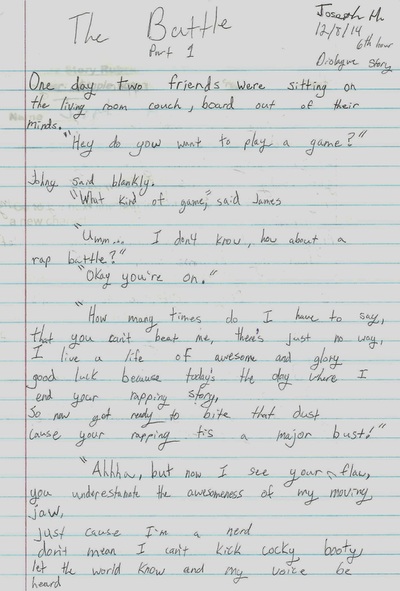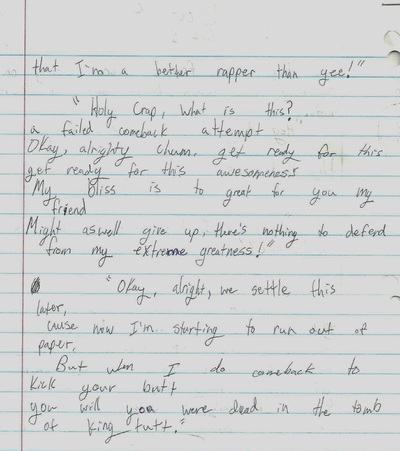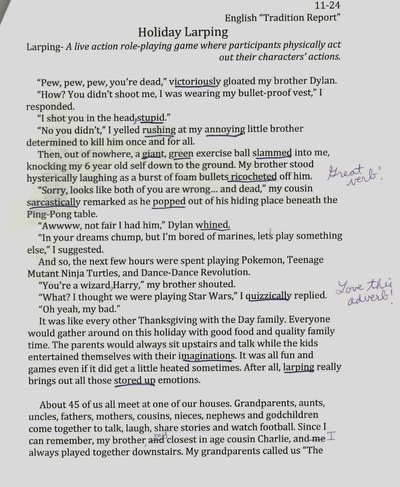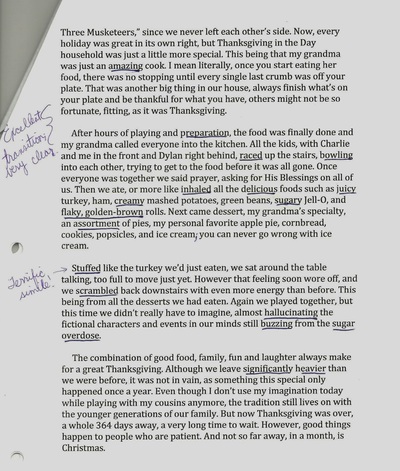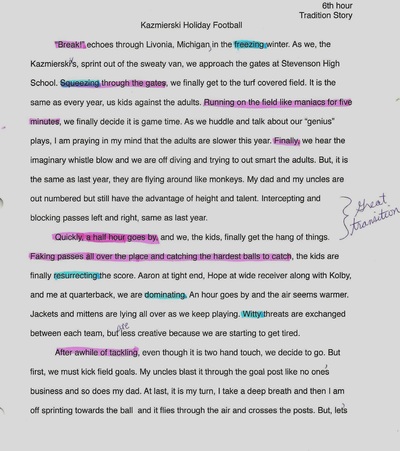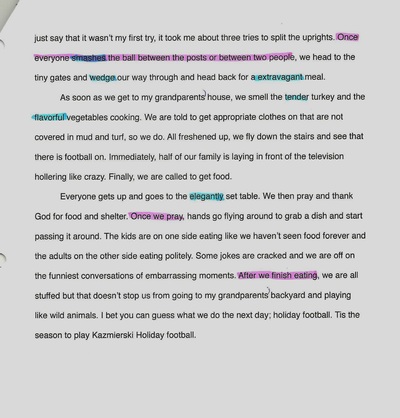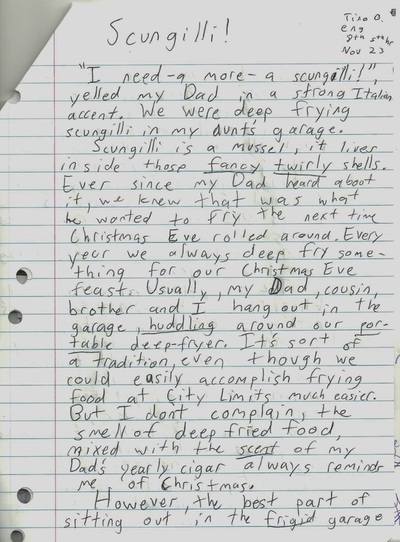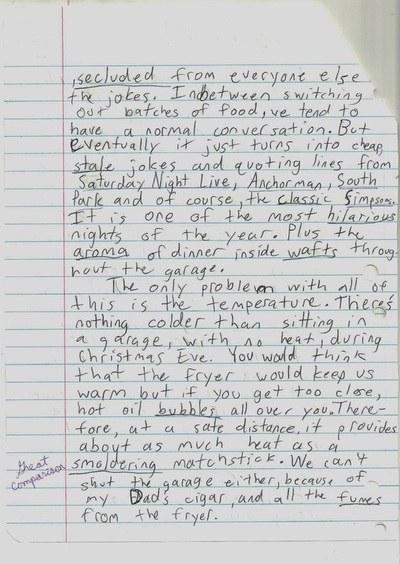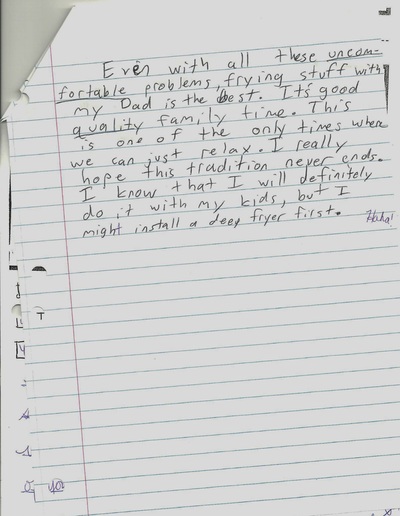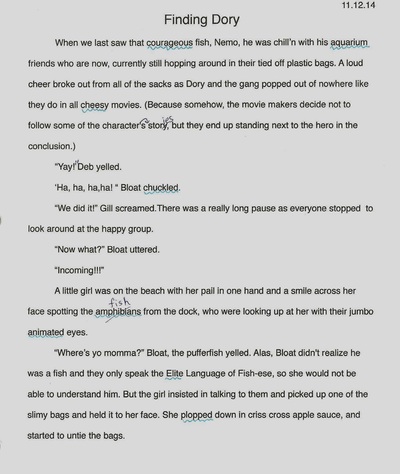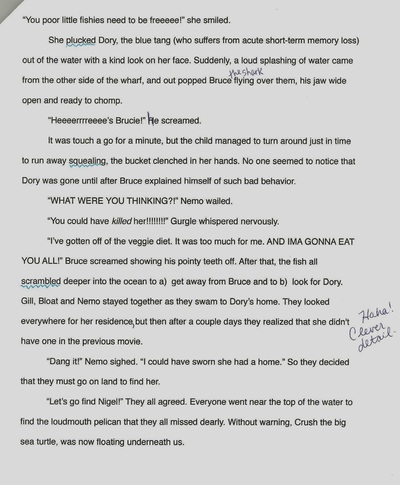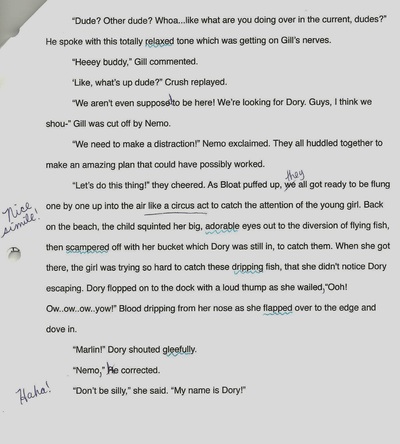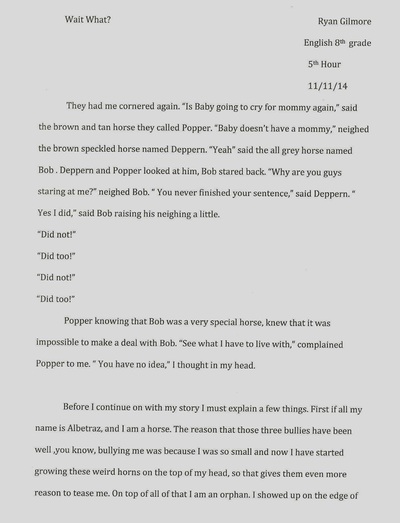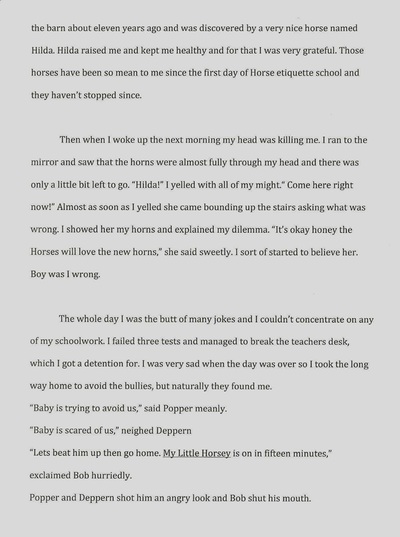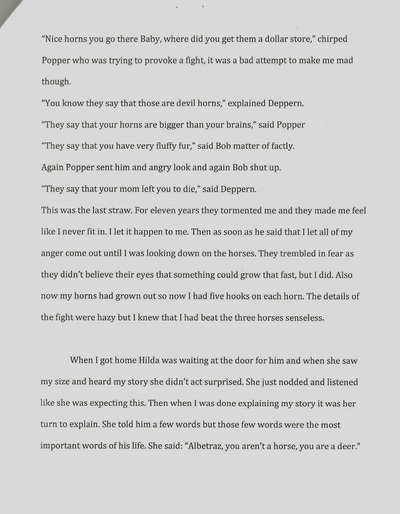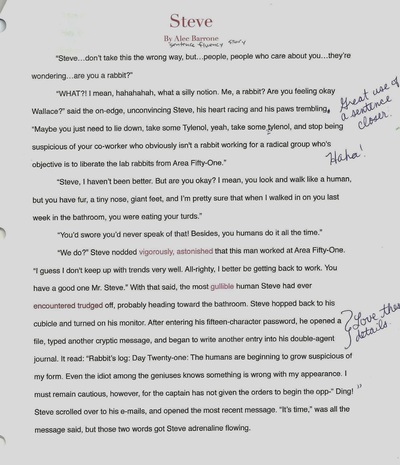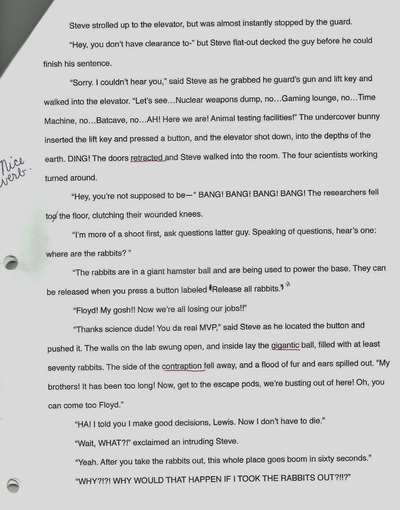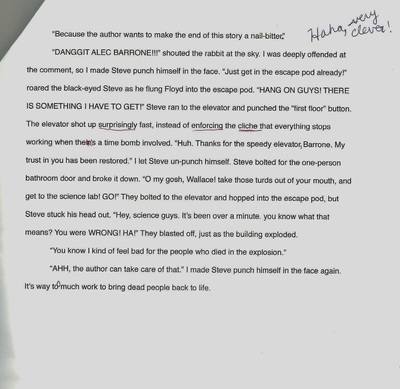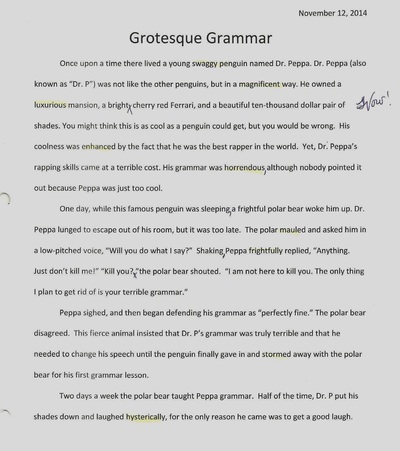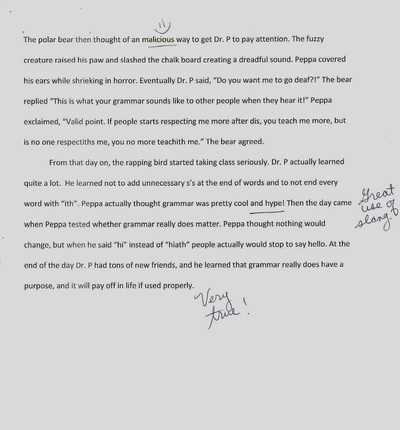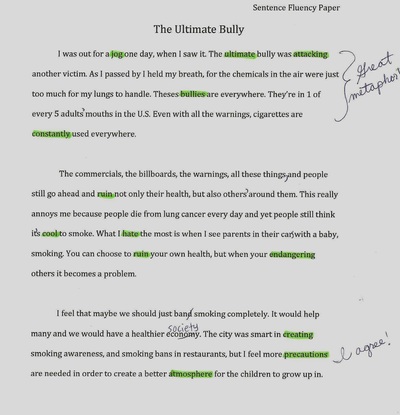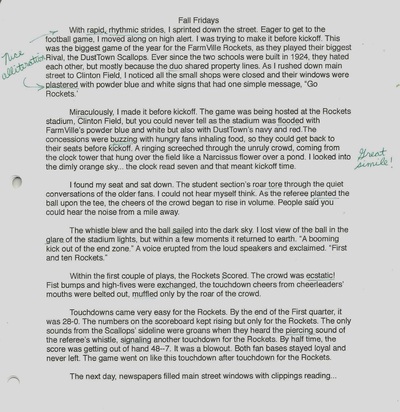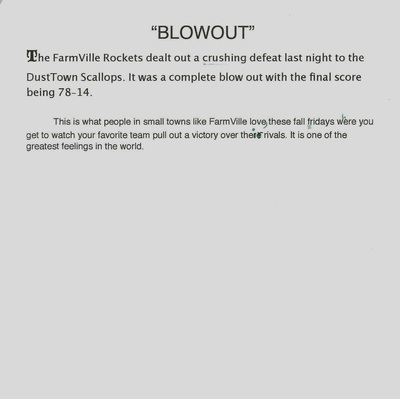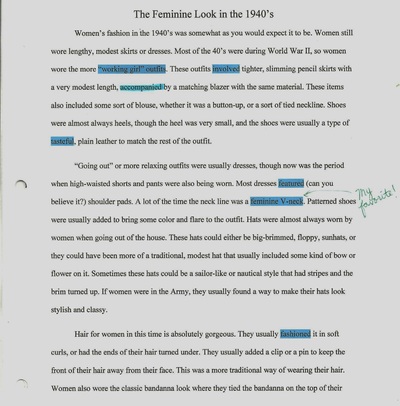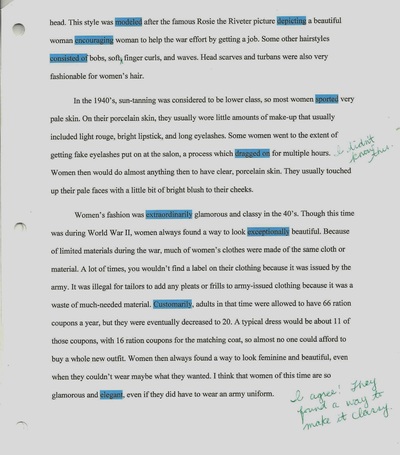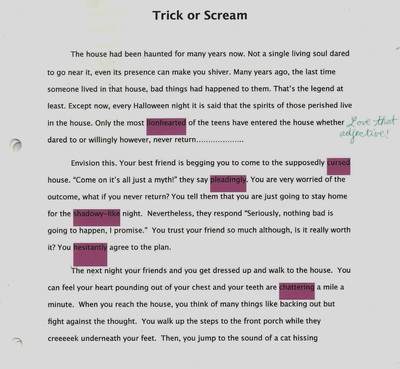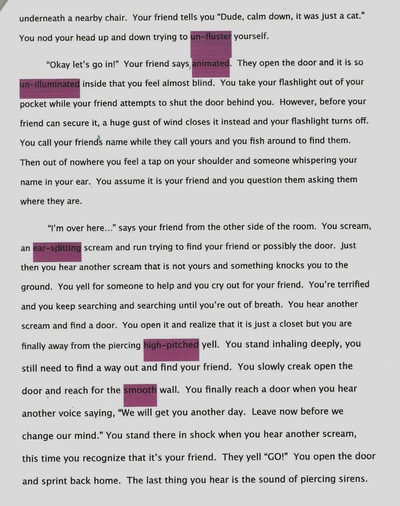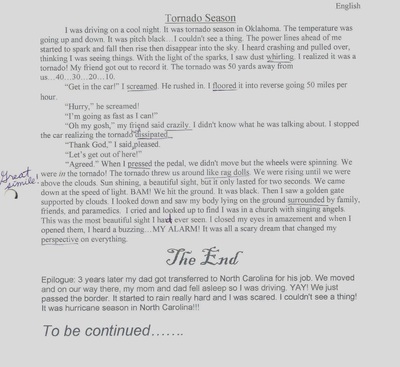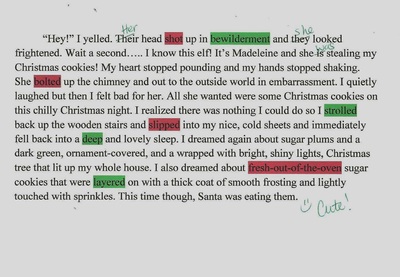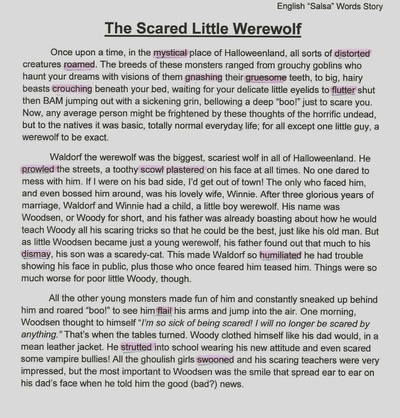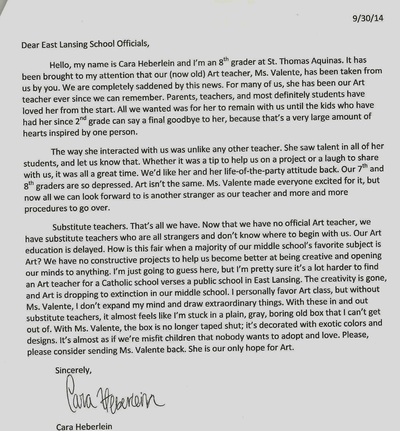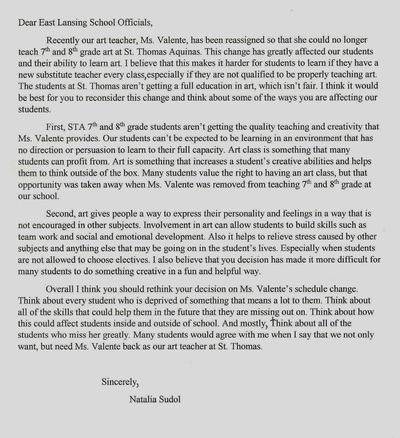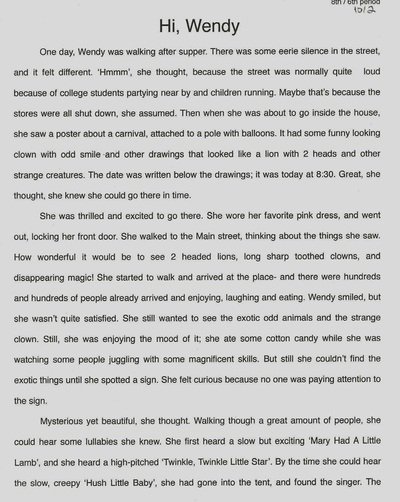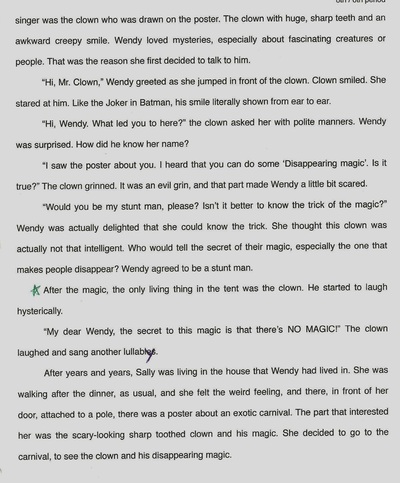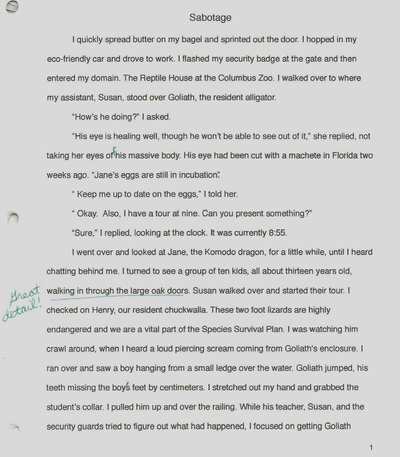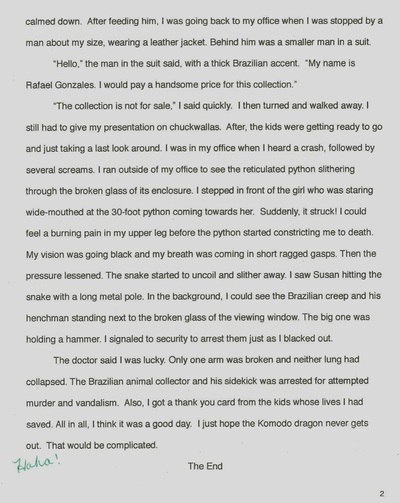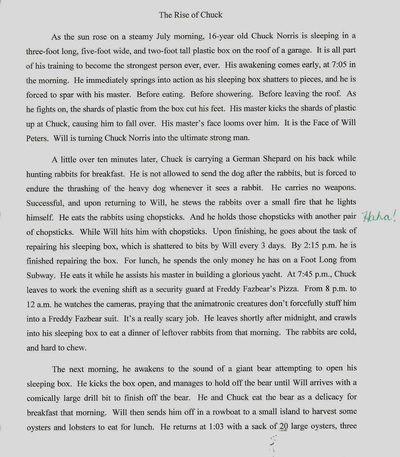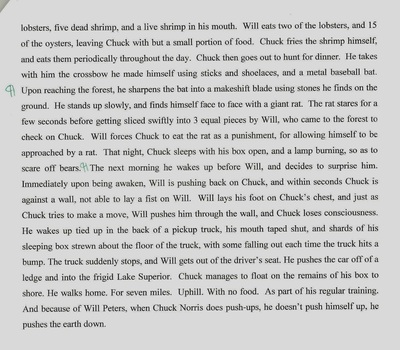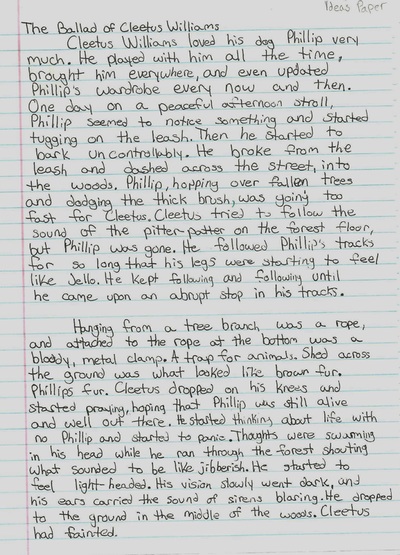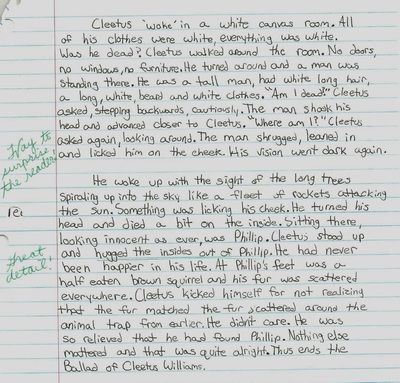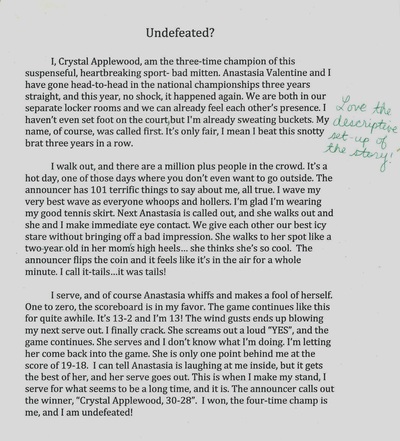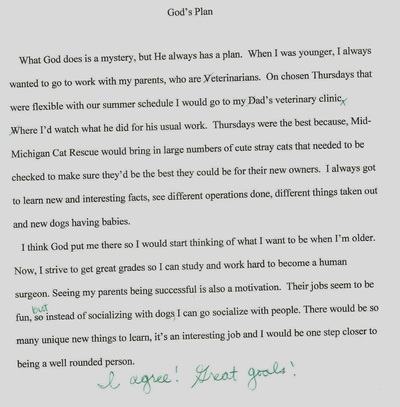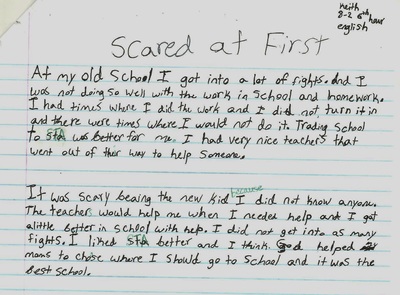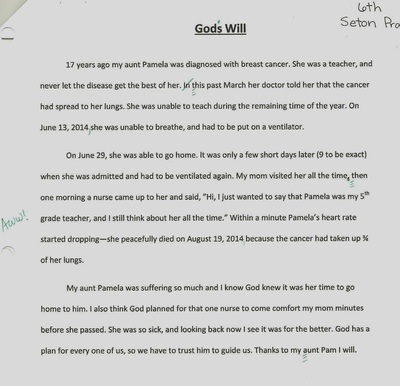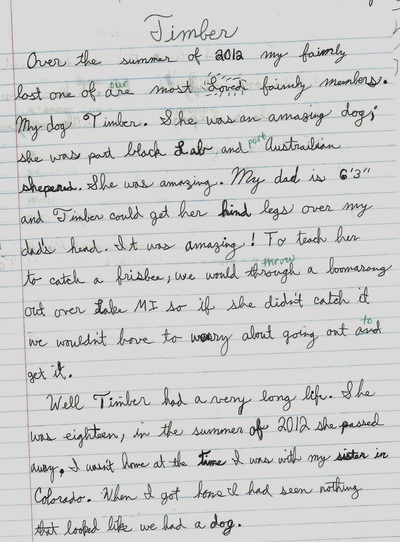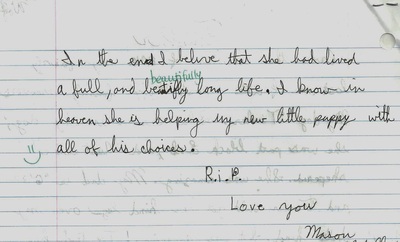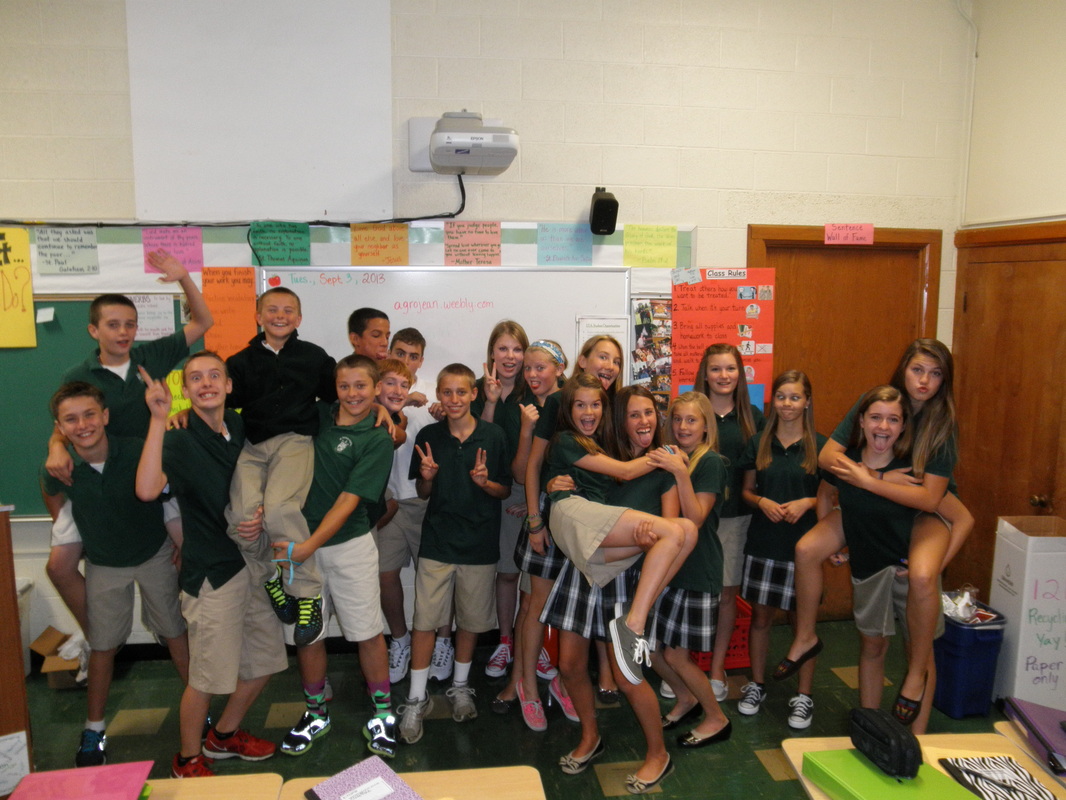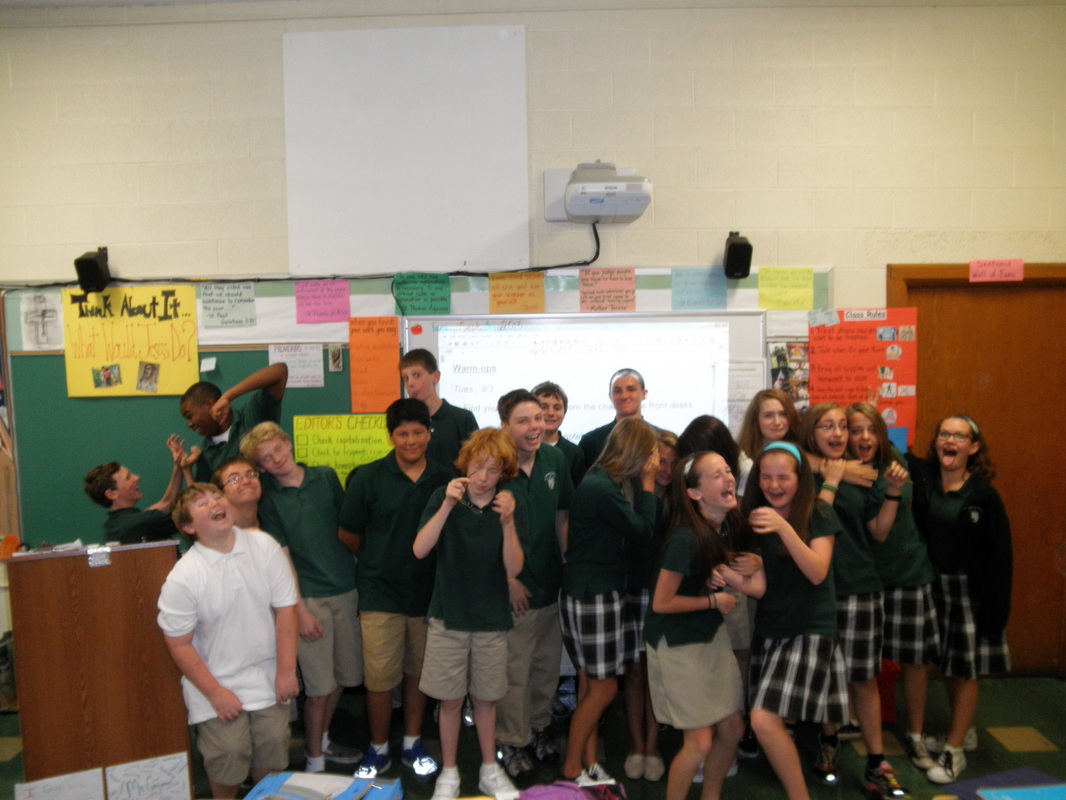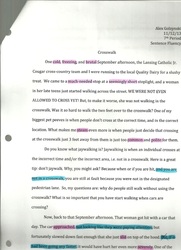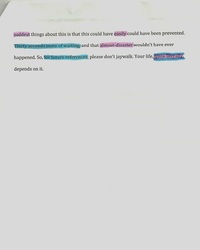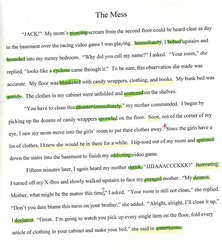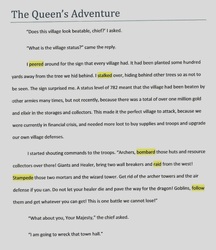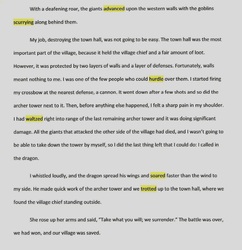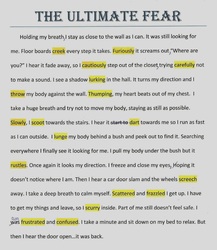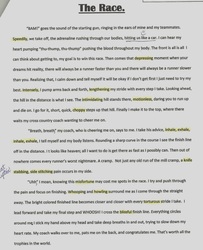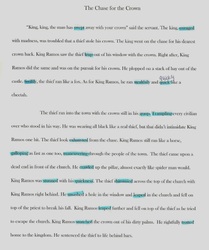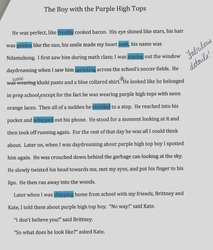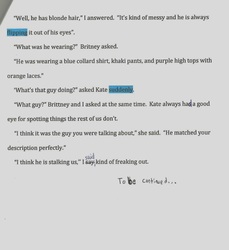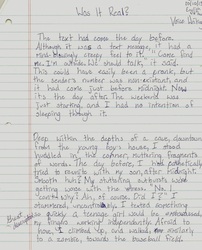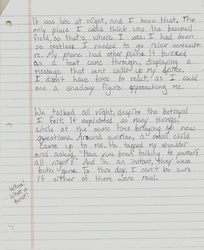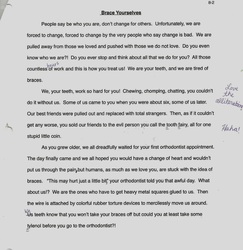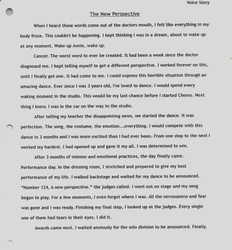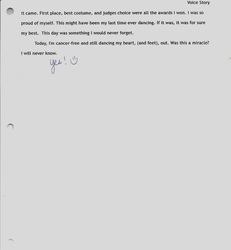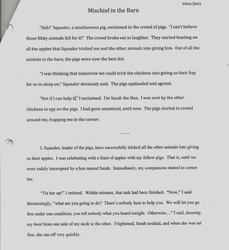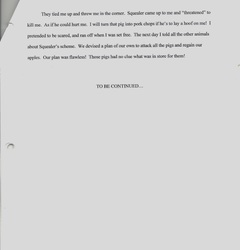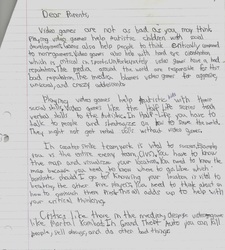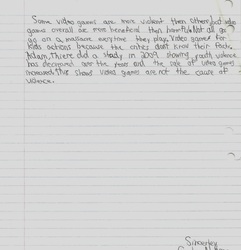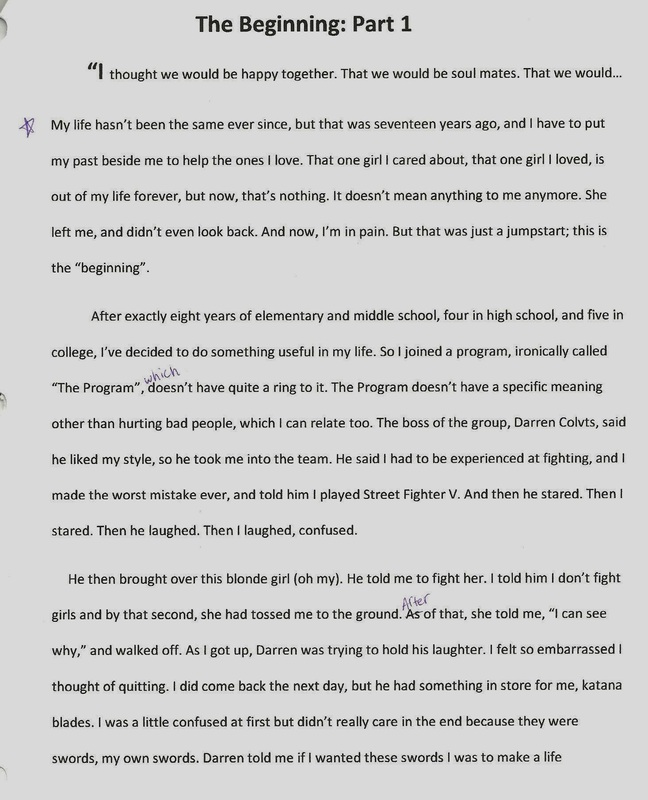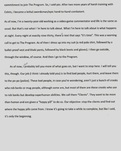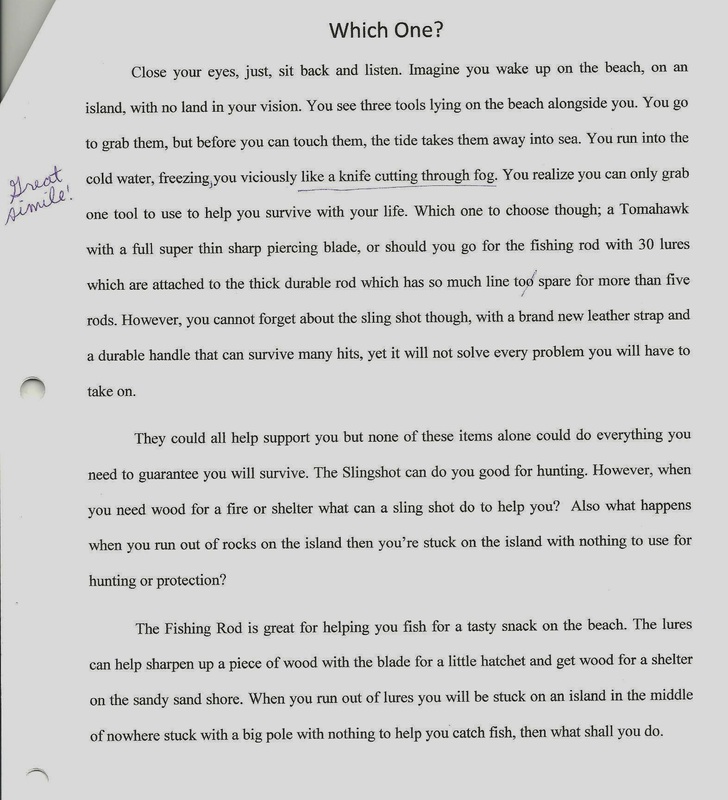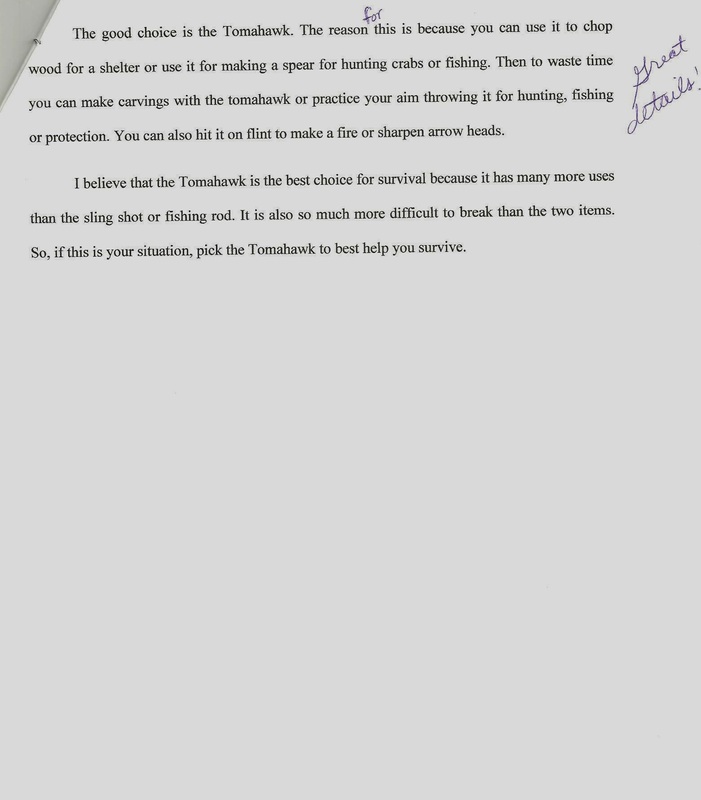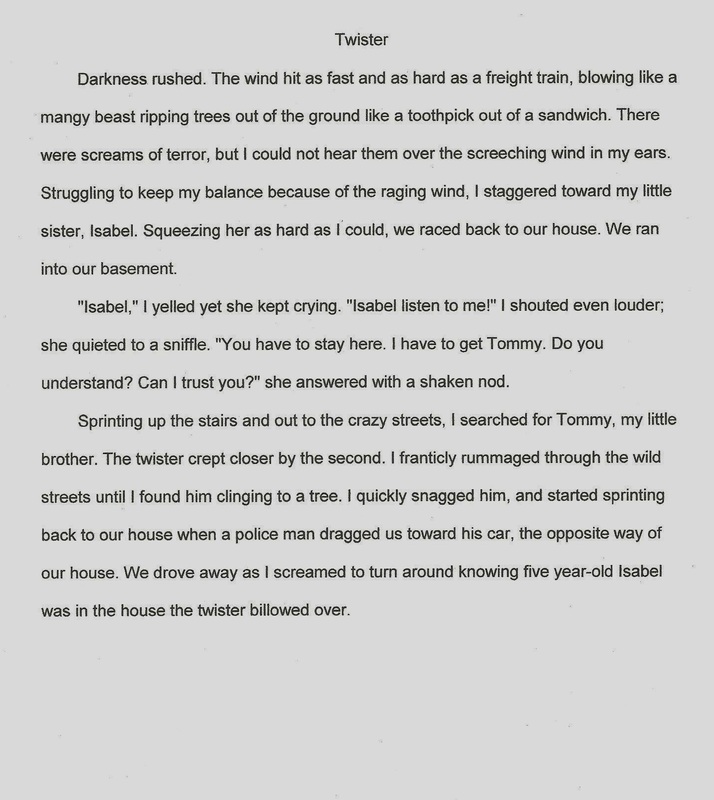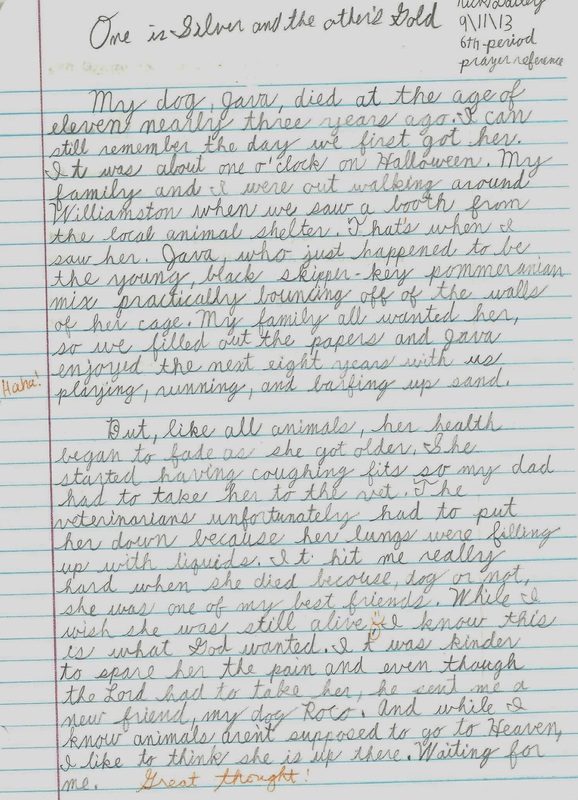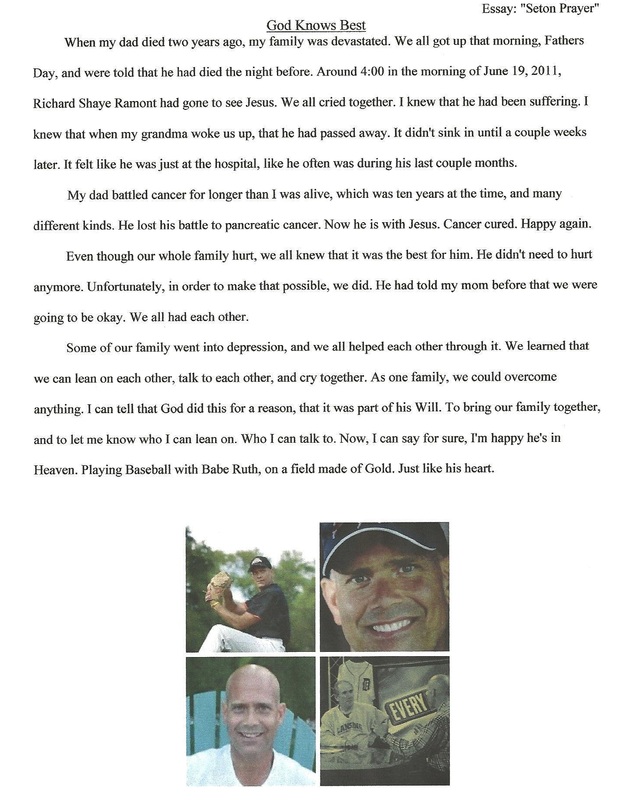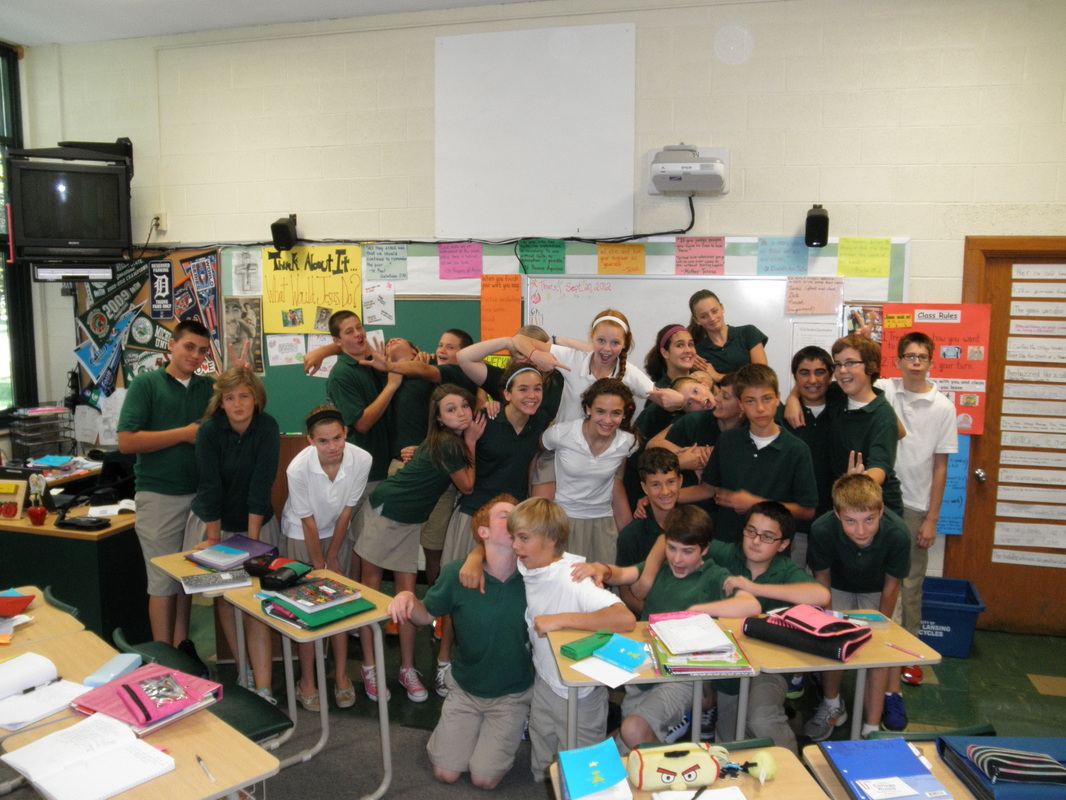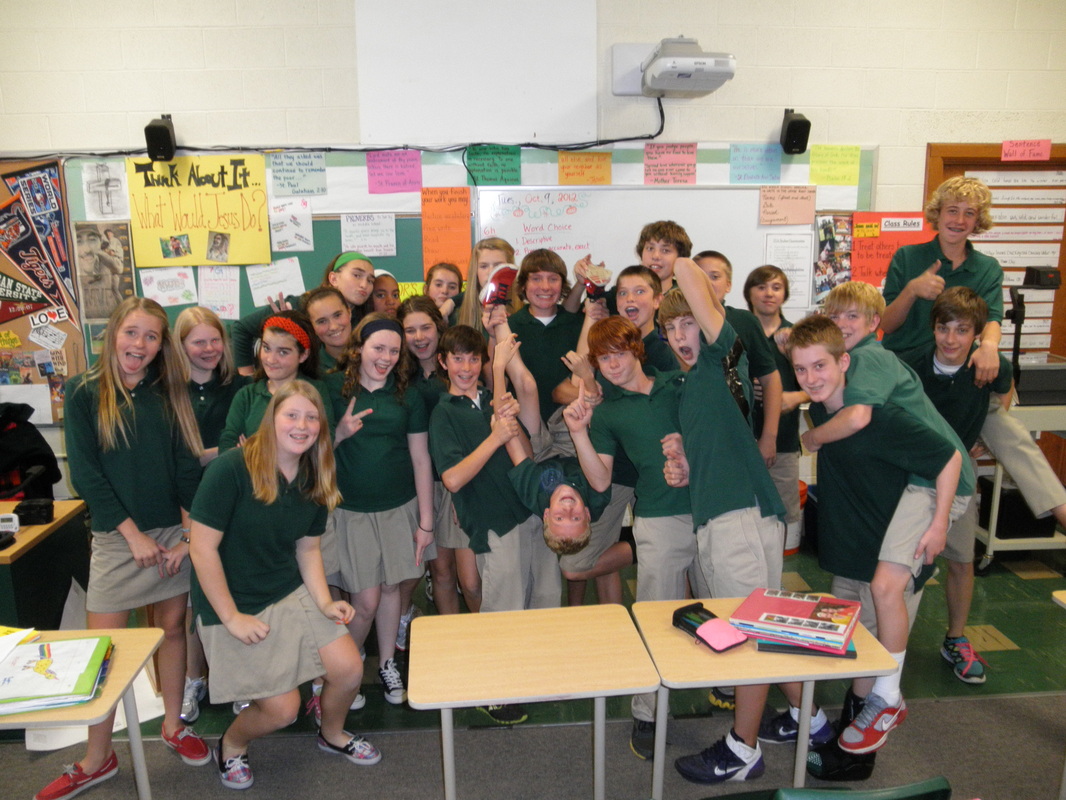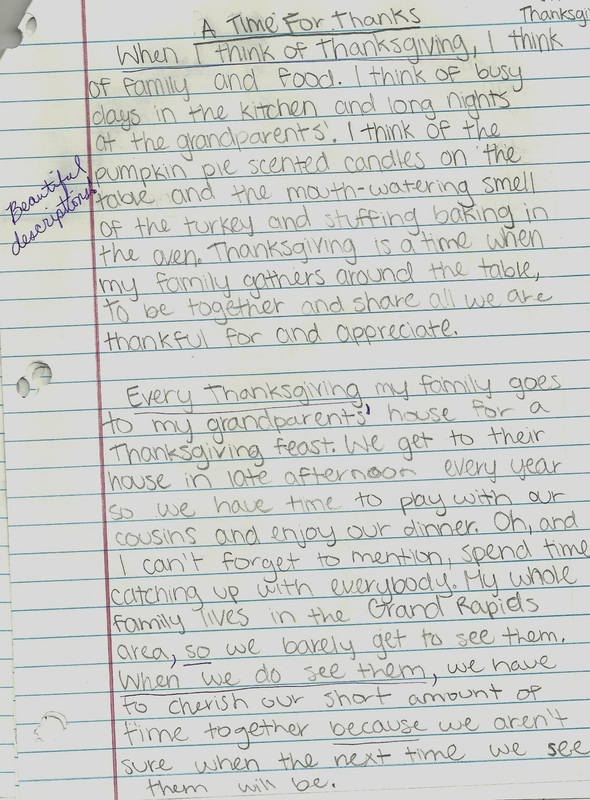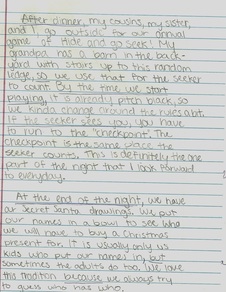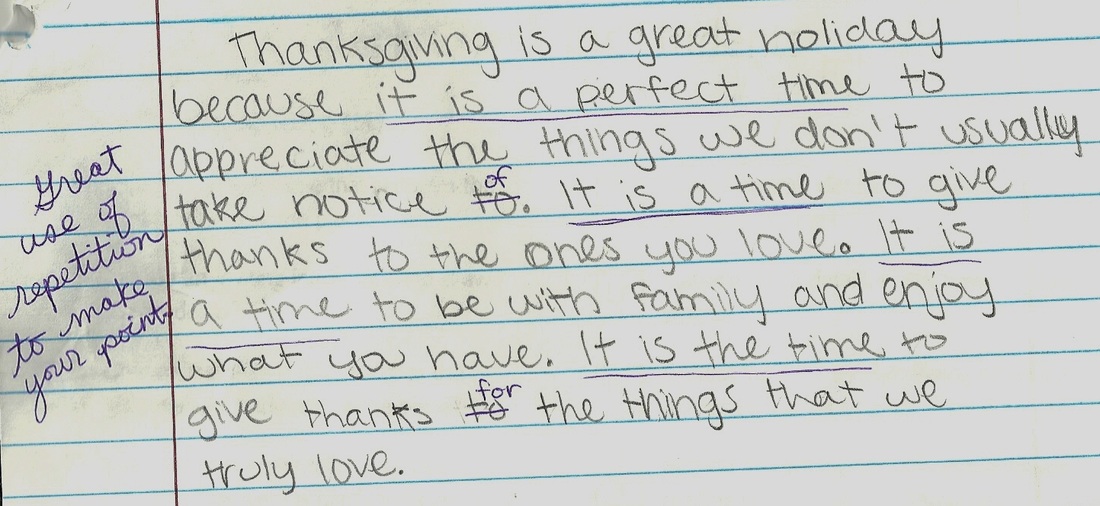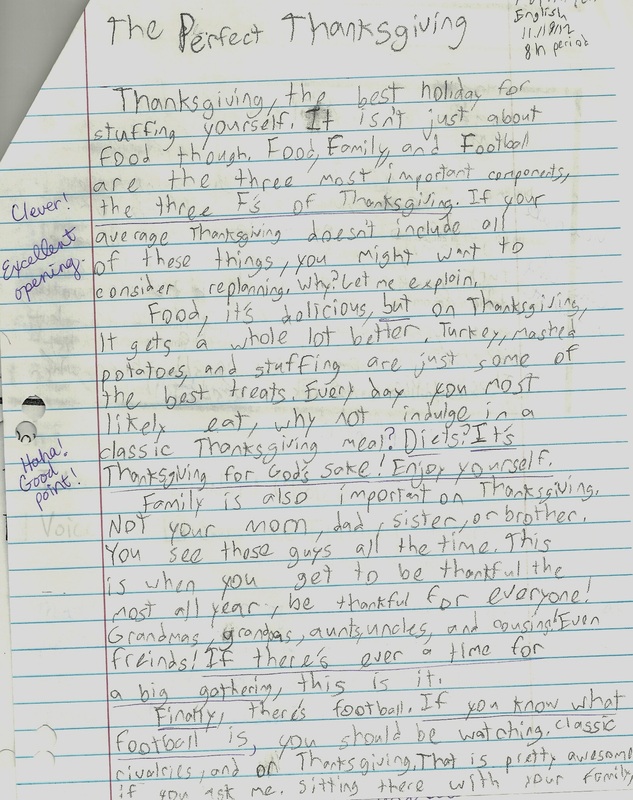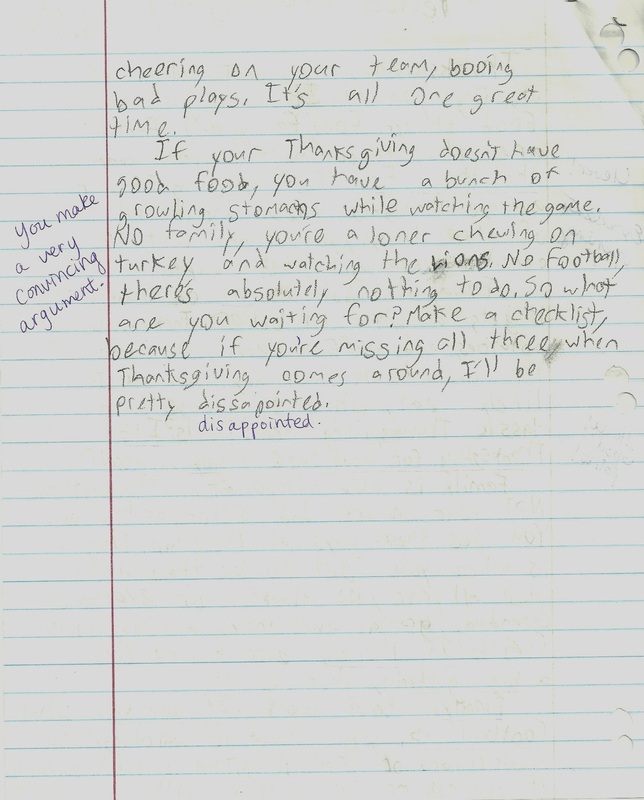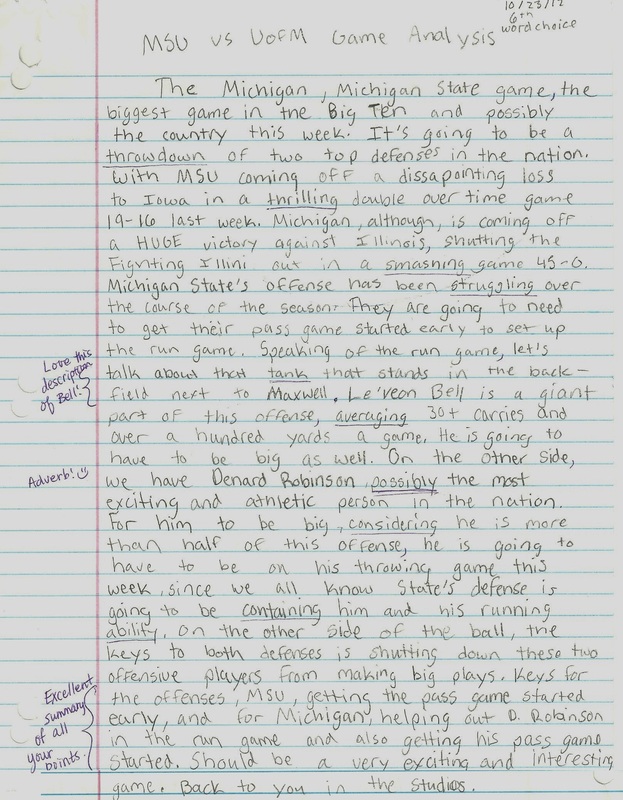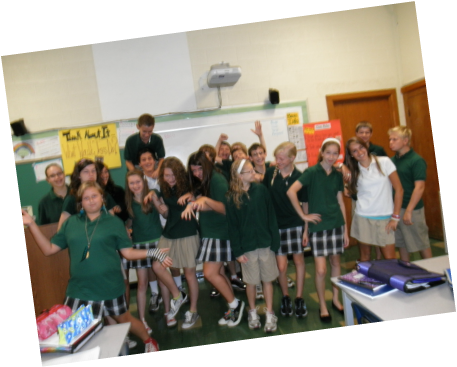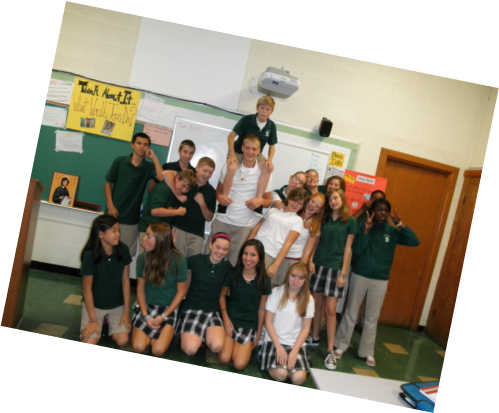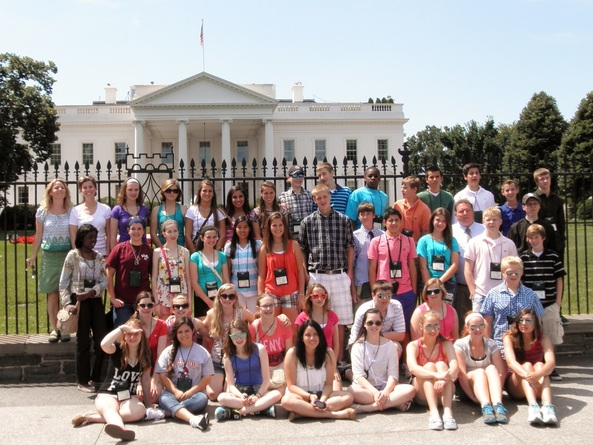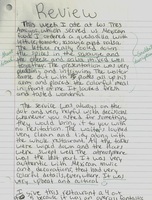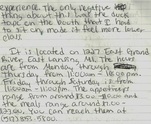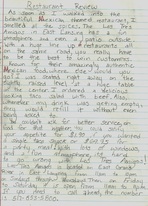Excellent Eighth Graders!
Scroll down to see excellent 8th grade work.
Scroll down to see excellent 8th grade work.
2017-2018 Eighth Graders
2016-2017 Eighth Graders
Saving the Elephants essays: Using informational text evidence to answer essay questions
Tommy B., Clare C., Evan F., Brendan M., Donovan P., Jackson V., & Sabrina Y.
Tommy B., Clare C., Evan F., Brendan M., Donovan P., Jackson V., & Sabrina Y.
The Giver: comparing and contrasting the book and movie
Abbey B., Madison K., Mary Elizabeth L., Maddie O., Andrew W., & Sabrina Y.
Abbey B., Madison K., Mary Elizabeth L., Maddie O., Andrew W., & Sabrina Y.
Dialogue Stories: Students practiced using correct dialogue format on a story topic of their choosing.
Noel S., Andrew W., Mary Elizabeth L., & Brendan M.
Noel S., Andrew W., Mary Elizabeth L., & Brendan M.
2015-2016 Eighth Graders
Restaurant Reviews: We took a trip to Los Tres Amigos and Tasty Twist and everyone wrote a restaurant review afterward.
Emma S. Lauren B. Trevor B.
Very Impressive WWI Reports: Students spent several weeks researching and composing reports on a topic related to WWI and were required to prove a thesis based on their research.
Thomas A.
Adeline H.
Hannah H.
Noah J.
Gina M.
"Organization" is another of the 6 Traits of Writing that we worked on. Organization focuses on staying on topic within each paragraph and using transitions to connect one thought to the next. Each student wrote about their family's Thanksgiving traditions.
Christine A. Casey F.
Lauren B. Trevor B.
"Sentence Fluency" is another of the 6 Traits of Writing. Students worked on varying their sentence openers and having a mix of long and short sentences in order to create a flowing piece of writing. Many students chose to write on the topic of one of their pet peeves.
Elise C. Will L.
Hailee B. Sara E.
"Word Choice" is another one of the 6 Traits of Writing. Students focused on using interesting, or "salsa" words to spice up their writing.
Zach G. Rachel R. Ryan R.
Hannah H. Kion N. Nathan W.
The next of the 6 Traits of Writing is "Voice". Students geared their writing to specific audiences, trying to bring about particular emotions in their readers.
Hailee B. Ella S.
Claire S. Gina M.
"Ideas"--one of the 6 Traits of writing. These students each did an excellent job of writing about a narrow, specific idea that included many relevant and descriptive details.
Sam E. Emily G. Mary Cate H.
Dylan D. Laura H. Eli M.
Some fabulous writing relating our experiences to St. Elizabeth Ann Seton's life (following God's will and recognizing His plans for us):
Adeline H. Griffin H. Emma S. Tucker T.
2014-2015 Eighth Graders
Wonderful WWI Research Reports:
Lauren C.
Ryan G.
Hannah O.
Abby L.
Delightful Dialogue Stories:
Laney N. Jesse I. Joe H.
"Organization" is another of the 6 Traits of Writing that we worked on. Organization focuses on staying on topic within each paragraph and using transitions to connect one thought to the next. Each student wrote about their family's Thanksgiving traditions.
Colin D. Abby K.
Tino O.
"Sentence Fluency" is another of the 6 Traits of Writing. Students worked on varying their sentence openers and having a mix of long and short sentences in order to create a flowing piece of writing.
Bea C. Ryan G.
Alec B. Justin S. Cameron M.
"Word Choice" is another one of the 6 Traits of Writing. Students focused on using interesting, or "salsa" words to spice up their writing.
Jake P. Abby L. Lauren C.
Drew S. Natalie H. Sophie M.
The next of the 6 Traits of Writing is "Voice". Students geared their writing to specific audiences, trying to bring about particular emotions in their readers.
Cara H. Natalia S. Hanna K.
"Ideas"--one of the 6 Traits of writing. These students each did an excellent job of writing about a narrow, specific idea that included many relevant and descriptive details.
Brian R. Jimmy R.
Blake P. Izzie B.
Some fabulous writing relating our experiences to St. Elizabeth Ann Seton's life (following God's will and recognizing His plans for us):
Ezra L. Keith J. Grace H. Mason W.
2013-2014 Eighth Graders
"Sentence Fluency" is another of the 6 Traits of Writing. Students worked on varying their sentence openers and having a mix of long and short sentences in order to create a flowing piece of writing.
Alex. G. Jack S.
"Word Choice" is another one of the 6 Traits of Writing. Students focused on using interesting, or "salsa" words to spice up their writing.
Ethan O. Caitlyne M. Megan N.
Gabe L. Hannah J.
The next of the 6 Traits of Writing is "Voice". Students geared their writing to specific audiences, trying to bring about particular emotions in their readers.
Adam G. Grace S. Sophie J.
Lidia Carter M.
"Ideas"--one of the 6 Traits of writing. These students each did an excellent job of writing about a narrow, specific idea that included many relevant and descriptive details.
Jason M. Paul R. Rebecka P.
Some fabulous writing relating our experiences to St. Elizabeth Ann Seton's life
(following God's will and recognizing His plans for us):
Nick D. Sophie R.
2012-2013 Eighth Graders
Excellent research reports on WWI topics:
Sarah H.
Lenah Higbee
Not many people know anything about Lenah Higbee. However, she played an important role in WWI. She was the second Superintendent of the U.S. Navy Nurse Corps and a wonderful leader. The Navy Nurses bloomed under Superintendent Lenah Higbee. Without her, the nurses would not have been able to save as many lives as they did.
Lenah Higbee was born in Chatham, New Brunswick in 1874. When she was older, she started training to be a nurse, and she graduated from the New York Postgraduate Hospital in 1899. Lenah got a job at the U.S. Naval Hospital in Washington D.C. after doing some private practice. She worked there for a few years. On October 1st, 1908, Lenah joined the U.S. Navy Nurse Corps. Also known as the “Sacred Twenty”, all the women in the group were known as the first women to formally serve as members of the Navy. The group worked hard and taught people about nursing.
In April 1909, Lenah was promoted to Chief Nurse. She left the U.S. Naval Hospital in Washington to work at the U.S. Naval Hospital in Norfolk, Virginia. Lenah was Chief Nurse for two years before being promoted to Superintendent on January 20th, 1911. She was the second superintendent of the Navy Nurse Corps. She led for 10 years as Superintendent.
As a Superintendent, Lenah got more people to join the Corps. Lenah also directed corps development and expansion to handle the wartime demands, kept close contact with her Chief Nurses, and encouraged and guided her nurses. She also refused to lower the strict standards for admittance to the Corps, and she frequently contributed articles to professional journals such as the American Journal of Nursing and encouraged her nurses to do the same. “Undoubtedly the future status of the Navy Corps will rest largely in the hands of its members, and especially is this true of the first nurses. If they are content with low standards professionally, morally, or socially the status of the corps will be fixed for all time. Future women will accept the standard set by us now without question; if it be high they will rise to it, if it be low they will with equal facility drop to its level.” (Sterner, 33)
An example of one of the first things that Lenah was in charge of was sending nurses to Guam. The Navy Nurses arrived in Guam in 1911. They were all horrified at what they saw. The living was primitive, the food was limited and there was a lot of polluted soil. There were not enough quarters for sick wives or the children of the military men at the Naval Hospital. Also, cockroaches, lizards, and centipedes were everywhere. To make matters worse there were a lot of earthquakes and typhoons. However, this didn’t stop the nurses from doing some amazing things. They started a formal nursing program for the natives. At the end of two years the new nurses were awarded a diploma, a pin, and a midwife certificate.
Higbee really cared about her nurses, and she stood up for nurses Humphrey and Anderson when they were found guilty of some charges while working in Samoa to set up a training school. Humphrey and Anderson were sent to Samoa to set up a training school but they got wrong and demeaning orders by some medical officers and never were able to set up the school. They asked to be discharged and that’s when the officers made a complaint against them. Higbee fought against the charges and on January 28th, 1914, Humphrey and Anderson were allowed to remain in Samoa. Lenah was also like a mother hen, encouraging the nurses to continue displaying their “splendid professional qualifications”. However she had strict rules including that no nurses were allowed to fraternize with the men or the patients.
Another example of Lenah sticking up for her nurses was when they were getting paid less than the Army Nurses. On November 22 1918, Higbee wrote a letter to the chief nurse at the Great Lakes Hospital saying “I am working very hard to have the pay of the Chief Nurses restored and also to have the grade of Assistant Chief Nurse with one half the pay of Chief nurse and if this gets through, I believe that we will get better results from our Assistant Chief Nurses.” (Sterner, 56).
In June 1920, Congress authorized relative rank for Army nurses. The Navy Nurses were supposed to have the same pay and benefits as the Army Nurses, so they wanted relative rank too. Under relative rank the Superintendent would become a Major, Assistant Superintendent and Directors- Captains, Chief Nurses- 1st Lieutenant, other nurses- 2nd lieutenant. In September of 1921, Surgeon General Edward R. Stitt agreed that the nurses should have relative rank, but then changed his mind. The final decision was that the Navy Nurses were not entitled to relative rank.
In April of 1921, Mary H. DuBose aired a complaint against Lenah Higbee about how she was running things. Lenah decided to resign with the allegations and with fatigue of long years of service. On November 23, 1922, Lenah resigned. It was viewed as an important event, even though she was a woman. Her resigning was effective on November 30th. Lenah stated “I now desire a new occupation.”(Sterner, 64) Lenah was awarded the Navy Cross and the Victory Medal for all that she had done since she became a nurse.
Lenah Higbee died suddenly in Winter Park, Florida in 1941. She was 66 years old. Lenah was buried with her husband, who had been a marine, in the Arlington cemetery. Three years later, the 1st combat ship ever named after a service woman, the USS Higbee, was named after her. The USS Higbee was commissioned on January 27th, 1945. Lenah’s sister, Mrs. A.M. Wheaton christened it.
The Navy Nurses bloomed under Superintendent Lenah Higbee. Without her, the nurses would not have been able to save as many lives as they did. Lenah was an inspiration to many nurses and a wonderful leader. Lenah brought the nurses closer together. In all Lenah Higbee was an important person in World War I.
Works Cited
Godson, Susan H. Serving Proudly: A history of Women in the U.S. Navy. Annapolis, MD: Naval Institute
Press, 2001. Print.
“Lenah Higbee.” www.boards.ancestry.com/surnames.higbee/129/mb.ashx.18 march 1999. 1. Web.25 Feb
2013.
Sterner, Doris M. In and out of Harm’s Way. Seattle, Washington: Peanut Butter Publishing.1997.Print.
http://www.arlingtoncemetery.net/lhshigbee.htm August3, 2007. 1. Web. 25 Feb 2013
Cassidy W.
Animals, In Fact, Can Be More Helpful Than Humans
When picturing WWI, you don’t think of camels walking around the battlegrounds, do you? Well, there were not only a couple of camels used, but tons during WWI! During the war, horses, donkeys, glowworms, dogs, pigeons and water animals were used all over. All of those animals helped out with some important task at some point during the war, whether it was carrying messages long distances for the troops or providing transportation, they had a huge impact on the war and the soldiers. During the war, people relied on the animals for communication, transportation and food supplies. Without the help of these animals, the war effort would have been much more difficult.
Imagine, looking out onto the war-torn battlefield and seeing living and dead horses everywhere. They did everything from providing transportation to processing in funerals for important soldiers. Horses were in far more dangerous situations than soldiers were during war because they were big and easy targets for bullets. Also, when soldiers had to ride a long distance in a war zone, the opposite fighting group would shoot at the men and a lot of times it ended up hitting the horse instead. Soldiers also shot horses for their meat if they were deprived of food. “The movie ‘War Horse’ is a great example of the horrible events horses and humans had to witness during the war” (History.com Staff, web)
Horses have, in fact, seen more action in the wars than any other animal. Horses were relied on to bring guns and other necessary supplies to the front on a daily basis. They were used to carry food from the base to the battle area. It took approximately 2 million pounds of fodder to feed all of the horses that were involved with the war, every day. Thousands of horses died of exhaustion, diseases and poison gas attacks. Because there were so many gas and bomb attacks on the front, horses, just like humans, had to wear armor and gas masks to protect themselves. During WWI alone, 10 million soldiers died as well as 8 million horses.
Calvary units became popular in 1917. Horses were put into units with more than 165,000 horses total. The Austrian Calvary unit had the smallest amount of horses used in war. They mobilized over 600,000 horses throughout the whole war. With the second smallest cavalry unit, the Germans put over 75,000 horses to work during WWI. With the biggest horse unit, the Russians mobilized over 27 cavalry units with over one million horses total. In 1914, there were 5,000 horses in an infantry division. An Infantry division consisted of 10,000-30,000 soldiers and 5,000 horses. A British cavalry unit made a statement by riding through the Grand Palace at Ypres which triggered the war in Ypres.
During WWI, dogs were also pretty big contributors. They were commonly used to drag machine guns through the trenches. Dogs were also a big part of the communication system. They helped run a communication “device” called the British Trench Set. The British Trench Set was attached to dogs and pigeons backs because if it was attached to a person it could be too easily destroyed. Dogs were also used for carrying food down in the trenches. Dogs were good for that job because of course they didn't mean as much as humans did. They were also used to locate dead bodies because they have such a good sense of smell.
There was one extremely famous dog named Sergeant Stubby, “The most famous animal to emerge from any war” (Philip R. Devlin). Stubby walked into a army training camp one day as a stray dog. All of the soldiers at the Yale University training campus thought this Pit bull, Terrier and Bulldog mix was they cutest thing they had ever seen. Next thing they knew, Sergeant Stubby started participating in drills and eventually learned how to salute with his right paw. After that, Private J Roberts Conroy took ownership of him. Soon, Stubby was brought to France with his division. While on the journey, he was stored below the S.S. Minnesota. Once in France, Stubby learned how to alert soldiers when toxic gases were near and also learned to find dead bodies. He even captured a undercover German spy with small amounts help from the humans. Sargent Stubby died in 1926 and left behind a very sad regiment.
Camels were not something you expected to see near a war zone, but they were everywhere. There definitely weren't as many camels as horses though. Camels were an efficient transportation source because they could go quite a while without having any food or water. They also helped with a lot of different military experiments. Camels could also handle more extreme weather so, they took part in multiple combat missions mainly in the Middle East and Africa. Camels were drafted to Canada by the U.S... The United States Camel Corporations purchased 60+ camels and shipped them to America in the 1850s. Camels were then expelled from war because they continued spooking other animals.
Another major role player in WWI was Carrier Pigeons. Canadians used them to symbolize that there was still war on the Western Front. Pigeons main use was carrying messages and communicating with other troops. There is one main Pigeon that stands out in everyone’s mind when they think about WWI birds and that’s Cher Ami. Cher Ami means “dear friend”, when translated into English. Cher Ami was a dear friend to the soldiers. He was a black Homing pigeon that was part of the 77th division of the U.S. military signal corps. He was on a mission with two other pigeons but, the others were both shot and killed during flight. Cher Ami survived multiple bullet wounds and multiple areas of poison gas. The famous message that he was to deliver was attached to his leg in a bottle and it read, “We are along the 276.4, our own artillery is dropping a barrage on us, for heaven’s sake, STOP IT!” The message eventually got delivered and Cher Ami died right there on the spot.
Glowworms also played a pretty good sized role in WWI and trench warfare in general. They provided light in the trenches when it was dark. Glowworms were the most unlikely contributors in the war by far. The most common type of glowworm was called the Lampyris Notiluca or the European Glowworm. They emitted their light through their rear. According to a 2010 study, just 10 glowworms can provide the same amount of illumination as a modern-day roadway light. This process was called bioluminescence. Glowworms also could detect poison gas which helped the soldiers.
Water animals were also a contributor to the easier war effort. Although not as big as horses or camels, they helped a lot. Bottlenose Dolphins and California Sea lions were two main types of marine animal used by the U.S. Navy Marine Mammal program. That program was run by U.S. Marines who taught these animals to act as underwater spies. Killer Whales and seals were also occasionally used. They used those types of water animals because they were “smart” swimmers and have a great sense of echolocation. They were taught to guard harbors and ships by detecting unauthorized enemy divers. This operation was run secretly until the 1990`s.
During war, people relied on animals for communication, transportation and food. Without the help of these animals, the war effort would have been much more complicated. Horses were and forever will be the most memorable animals ever to help with the war. Although camels, dogs, birds, glowworms and marine animals were a uncommonly mentioned animals, they were big contributors to the war.” As the stories of Sgt. Stubby, Cher Ami, and the ordinary garden slug demonstrate, there are many more interesting tales to be told about the Great War as its centennial fast approaches.” (Philip R. Devlin, web)
"Organization" is another of the 6 Traits of Writing that we worked on. Organization focuses on staying on topic within each paragraph and using transitions to connect one thought to the next. Each student wrote about their family's Thanksgiving traditions.
Savannah C.
Matt H.
"Sentence Fluency" explores the concept of playing around with sentence structure--having a mix of long and short sentences and beginning them with dependent clauses such as adverbs, adverb clauses, and prepositional phrases. Here is a great student example:
Abigail G.
Christmas List
Walking into my old elementary school, with a cup of home brewed, hot coffee in my hand, I took a breath, seeing the cloud of air that came from my mouth. Carefully opening the nice, sturdy double doors, I tried not to spill the drink that I had brought to my mom while she taught her adorable, little 3rd graders. For some reason, my high school got out for winter break a week before any other schools, so I was going to help my mom with grading. I strolled down the familiar hallway, until I heard my mom’s comforting, caring voice that was teaching her students how to multiply double digits. Entering her cozy classroom, my nostrils were filled with a yummy smell. It smelled like pine trees in the middle of winter, similar to the smell of our house down the road from school. I tried to sneak in so that I would not disturb class, but as I moved to my mom’s wooden desk, I could sense the curious eyes watching me as I set my car keys and my phone on the table.
“Who’s that?” Clara, a little girl, asked while pointing in my direction. Now everybody’s eyes were on me.
“This is my youngest daughter, Bethany. She will be helping me out this week to grade papers. She is out of school already,” my mom explained. I did not here one ‘lucky’ or ‘not fair’ from any of the students. I guess my mom really is one of the best teachers that you’ll ever have. I finally sat down and began to correct science papers, math papers, social studies papers- then I came to a piece of writing:
What I Want For Christmas
Clara Adams
Dear Santa Clos
I hav ben a good girl this yeer. I want sumthing veary badly for Christmas. I want Sammy to get betr. He has ben a good boy two. He listns to all the doctrs. He takes his medisin when Mommy tells him to. He even plays with me when he feels okay. So Santa, I won’t ask for anething els this Christmas, exept to help Sammy. He is a gret oldr brothr and he does not diserv to hav cancr. Thank you so mush Santa! I will leev you extra milk this yeer because I know how mush you lik it.
Love Clara
I was awestruck. Half-way crying, I slowly put her paper to the side of the desk. I couldn’t mark her misspelled words, which would ruin the perfectness of her letter.
“Okay, during this time you can do homework, make-up work, coloring, reading, or free writing,” my mom announced to the class. The children put their textbooks away and then erupted in chatter. Ring! Ring! Ring! The gold bell was rung by my mom and the room immediately got quieter. If only that worked in my 11th grade classes, I thought. I was still thinking about Clara’s letter. I was going to show Mom, but she was meeting with a few students to discuss their grades, so I couldn’t.
Minutes later, I saw a small hand pop up in the air. I followed it down a tiny wrist, then a skinny arm, until I saw Clara’s face. She had thin, light brown hair, gentle eyes, and a smiling mouth. She is how I imagine an angel. I scurried over to her desk to answer her question. As it turns out, she didn’t have a question at all. At least not one related to school, anyways. “Your very pretty! Do you want to be friends?” Clara said with her usual perkiness. I was caught off-guard. What was I supposed to say?
“Thank you,’ said I said answering her first statement. “Of course I’ll be friends with you!”
“Really!” She exclaimed with wide eyes.
“Really-really!” I told her. She smiled, even though I knew on the inside she was worried about her brother.
After free time, all of the children were in the hallway yanking their snow pants on, pulling on their gloves, and tugging on their boots. Soon, they were sprinting out the door and in to the snowy winter wonderland. Clara was walking with another little girl to the swings when suddenly, she slipped backwards. Clara was crossing a slippery piece of ice when she fell back and bashed her head. Please be okay is all I thought. I ran as fast as I could to try to help Clara. When I got there, she was unconscious. I started bawling. “MOM CALL 9-1-1!” I shrieked.
Soon the paramedics showed up. They had to cart her to the ambulance. She was still unconscious. I saw her ,laying there, eyes closed. I was till crying.
Later that day, I wrote my Christmas list:
Dear Santa Claus,
For Christmas this year, I don’t want new shoes, new clothes, or a new bag. All I want is for Clara to get her wish and for her to get better. Thank you! I will leave you extra milk this this year because now I know how much you like it.
Love,
Bethany
Christmas List
Walking into my old elementary school, with a cup of home brewed, hot coffee in my hand, I took a breath, seeing the cloud of air that came from my mouth. Carefully opening the nice, sturdy double doors, I tried not to spill the drink that I had brought to my mom while she taught her adorable, little 3rd graders. For some reason, my high school got out for winter break a week before any other schools, so I was going to help my mom with grading. I strolled down the familiar hallway, until I heard my mom’s comforting, caring voice that was teaching her students how to multiply double digits. Entering her cozy classroom, my nostrils were filled with a yummy smell. It smelled like pine trees in the middle of winter, similar to the smell of our house down the road from school. I tried to sneak in so that I would not disturb class, but as I moved to my mom’s wooden desk, I could sense the curious eyes watching me as I set my car keys and my phone on the table.
“Who’s that?” Clara, a little girl, asked while pointing in my direction. Now everybody’s eyes were on me.
“This is my youngest daughter, Bethany. She will be helping me out this week to grade papers. She is out of school already,” my mom explained. I did not here one ‘lucky’ or ‘not fair’ from any of the students. I guess my mom really is one of the best teachers that you’ll ever have. I finally sat down and began to correct science papers, math papers, social studies papers- then I came to a piece of writing:
What I Want For Christmas
Clara Adams
Dear Santa Clos
I hav ben a good girl this yeer. I want sumthing veary badly for Christmas. I want Sammy to get betr. He has ben a good boy two. He listns to all the doctrs. He takes his medisin when Mommy tells him to. He even plays with me when he feels okay. So Santa, I won’t ask for anething els this Christmas, exept to help Sammy. He is a gret oldr brothr and he does not diserv to hav cancr. Thank you so mush Santa! I will leev you extra milk this yeer because I know how mush you lik it.
Love Clara
I was awestruck. Half-way crying, I slowly put her paper to the side of the desk. I couldn’t mark her misspelled words, which would ruin the perfectness of her letter.
“Okay, during this time you can do homework, make-up work, coloring, reading, or free writing,” my mom announced to the class. The children put their textbooks away and then erupted in chatter. Ring! Ring! Ring! The gold bell was rung by my mom and the room immediately got quieter. If only that worked in my 11th grade classes, I thought. I was still thinking about Clara’s letter. I was going to show Mom, but she was meeting with a few students to discuss their grades, so I couldn’t.
Minutes later, I saw a small hand pop up in the air. I followed it down a tiny wrist, then a skinny arm, until I saw Clara’s face. She had thin, light brown hair, gentle eyes, and a smiling mouth. She is how I imagine an angel. I scurried over to her desk to answer her question. As it turns out, she didn’t have a question at all. At least not one related to school, anyways. “Your very pretty! Do you want to be friends?” Clara said with her usual perkiness. I was caught off-guard. What was I supposed to say?
“Thank you,’ said I said answering her first statement. “Of course I’ll be friends with you!”
“Really!” She exclaimed with wide eyes.
“Really-really!” I told her. She smiled, even though I knew on the inside she was worried about her brother.
After free time, all of the children were in the hallway yanking their snow pants on, pulling on their gloves, and tugging on their boots. Soon, they were sprinting out the door and in to the snowy winter wonderland. Clara was walking with another little girl to the swings when suddenly, she slipped backwards. Clara was crossing a slippery piece of ice when she fell back and bashed her head. Please be okay is all I thought. I ran as fast as I could to try to help Clara. When I got there, she was unconscious. I started bawling. “MOM CALL 9-1-1!” I shrieked.
Soon the paramedics showed up. They had to cart her to the ambulance. She was still unconscious. I saw her ,laying there, eyes closed. I was till crying.
Later that day, I wrote my Christmas list:
Dear Santa Claus,
For Christmas this year, I don’t want new shoes, new clothes, or a new bag. All I want is for Clara to get her wish and for her to get better. Thank you! I will leave you extra milk this this year because now I know how much you like it.
Love,
Bethany
"Word Choice" is another of the 6 Traits of Writing. Students worked on adding "salsa words" to their writing in order to "spice it up". In other words, they are moving into more sophisticated writing by using strong vocabularies.
Jake R.
The next of the 6 Traits of Writing is "Voice". Students geared their writing to specific audiences, trying to bring about particular emotions in their readers.
Cassidy W.
He`s Gone!
The year was 1999 and Collin O`Hare, otherwise known as Daddy, had just been deployed to Afghanistan. Mama was left alone with a newborn and a 2 year old. The O`Hare family was fairly wealthy and had a huge, loving family. They lived in southern Ohio, about two houses down from a school that the kids would soon attend in the future. It was extremely devastating to Mama when father left.
10 years had passed. The child that was newborn when Daddy had left was now 10 and the child that was two is now 12. The youngest, Samantha, never really knew her Daddy, but had heard many great stories about him. Jimmy, the oldest, can vaguely remember Daddy. The main thing that sticks out to Jimmy when he thinks of Daddy is his shiny, bald head and his large Rolex watch. Jimmy hadn’t known that Daddy had died one week after deployment due to a shot to the neck while protecting his base. Every week, Jimmy would go up to his room on the top floor of the house and sit down at his old, wooden desk and write letters to his dad. Many of his letters were saying, “Daddy, please come home.” Or “Dad, this is serious, every time I mention your name mom breaks down in tears.”
Jimmy had been having a hard time in school lately. Everyone would tease him about his shaggy hair or his old torn and worn out shoes. One day after school, Jimmy burst out the school doors and started running home. Not long after he exited the school doors, he heard his name being called. He turned around to see his mother’s car. This was extremely unusual being that Mama worked until 5. He grabbed Samantha, who happened to be walking up behind him, and sluggishly walked towards Mamas car. As they get closer to the car, Jimmy spots and nice looking older man in the passenger seat. Samantha, yanks open the door and Mama begins to explain the odd man in the front seat. “Jimmy, Sam, this is Greg. He and I have been dating for almost a month and I thought it would be nice for you two to meet him.” Jimmy hopped out of the car and slammed the door. As he was doing so, he was yelling “How could you EVER try to even begin to replace Daddy.”
Jimmy ran home as fast as he could. He opened up the double glass doors at the entrance to his house and slammed them shut after he ran through. He dashed up the white, carpeted stairs and just barely made it to his room before breaking out in tears. As giant, salty teardrops ran down his cheek, he pulled out a piece of paper and began to write yet another letter to Daddy.
Dear Daddy,
Mama is going insane. She brought home a man today. I think she is trying to replace you. He is a tall business man named Greg. I miss you so much and I just want to run away. I am constantly getting teased for not having a dad at career day. I wish you would come home and teach me how to hunt or fish. Dad, what I am trying to say is PLEASE hurry home.
I love you,
Jimmy
Just then, Jimmy hears the big double doors open downstairs. He threw his pen down on the desk and sped over to the window. Jimmy opened the window, pushed out the screen and jumped onto the roof. From there he carefully jumped to the ground and ran faster than he ever had. Mama came upstairs and knocked on his door,” Jimmy… Jimmy, open this door right now young man.” No reply. She opens the door to see Jimmy nowhere in sight. Mama walks over to Jimmy’s desk and sees the letter. She picks it up and begins to read it. Mama starts to get angry but stops herself. She begins sobbing. Little did Mama know, that letter would be Jimmy’s last… Forever.
He`s Gone!
The year was 1999 and Collin O`Hare, otherwise known as Daddy, had just been deployed to Afghanistan. Mama was left alone with a newborn and a 2 year old. The O`Hare family was fairly wealthy and had a huge, loving family. They lived in southern Ohio, about two houses down from a school that the kids would soon attend in the future. It was extremely devastating to Mama when father left.
10 years had passed. The child that was newborn when Daddy had left was now 10 and the child that was two is now 12. The youngest, Samantha, never really knew her Daddy, but had heard many great stories about him. Jimmy, the oldest, can vaguely remember Daddy. The main thing that sticks out to Jimmy when he thinks of Daddy is his shiny, bald head and his large Rolex watch. Jimmy hadn’t known that Daddy had died one week after deployment due to a shot to the neck while protecting his base. Every week, Jimmy would go up to his room on the top floor of the house and sit down at his old, wooden desk and write letters to his dad. Many of his letters were saying, “Daddy, please come home.” Or “Dad, this is serious, every time I mention your name mom breaks down in tears.”
Jimmy had been having a hard time in school lately. Everyone would tease him about his shaggy hair or his old torn and worn out shoes. One day after school, Jimmy burst out the school doors and started running home. Not long after he exited the school doors, he heard his name being called. He turned around to see his mother’s car. This was extremely unusual being that Mama worked until 5. He grabbed Samantha, who happened to be walking up behind him, and sluggishly walked towards Mamas car. As they get closer to the car, Jimmy spots and nice looking older man in the passenger seat. Samantha, yanks open the door and Mama begins to explain the odd man in the front seat. “Jimmy, Sam, this is Greg. He and I have been dating for almost a month and I thought it would be nice for you two to meet him.” Jimmy hopped out of the car and slammed the door. As he was doing so, he was yelling “How could you EVER try to even begin to replace Daddy.”
Jimmy ran home as fast as he could. He opened up the double glass doors at the entrance to his house and slammed them shut after he ran through. He dashed up the white, carpeted stairs and just barely made it to his room before breaking out in tears. As giant, salty teardrops ran down his cheek, he pulled out a piece of paper and began to write yet another letter to Daddy.
Dear Daddy,
Mama is going insane. She brought home a man today. I think she is trying to replace you. He is a tall business man named Greg. I miss you so much and I just want to run away. I am constantly getting teased for not having a dad at career day. I wish you would come home and teach me how to hunt or fish. Dad, what I am trying to say is PLEASE hurry home.
I love you,
Jimmy
Just then, Jimmy hears the big double doors open downstairs. He threw his pen down on the desk and sped over to the window. Jimmy opened the window, pushed out the screen and jumped onto the roof. From there he carefully jumped to the ground and ran faster than he ever had. Mama came upstairs and knocked on his door,” Jimmy… Jimmy, open this door right now young man.” No reply. She opens the door to see Jimmy nowhere in sight. Mama walks over to Jimmy’s desk and sees the letter. She picks it up and begins to read it. Mama starts to get angry but stops herself. She begins sobbing. Little did Mama know, that letter would be Jimmy’s last… Forever.
One of the 6 traits of effective writing is called "Ideas." Choosing a very narrow, specific topic to write about allows the author to focus on details that will be important for the reader to understand. Here are some results of students' great ideas:
Drew H.
Honey Badger’s Vacation
Once upon a time there lived two of the most evil criminals in all the land. Their names were Honey Badger and Snakey da Snake. They ransacked all the homes of the animals. Honey Badger was a brutal animal who could tear down killer bees nests and wouldn’t even flinch. Snakey da Snake was the side kick and didn’t do very much work. Most of the time he would stay behind Honey Badger and knit his mother’s socks.
After years of this, Honey Badger was fed up with him for being lazy, knitting socks, and sleeping on the job. How could he be the most feared villain in all the land if he had an idiot for a right hand man? Honey Badger decided to take a vacation. Doing this he could finally get some rest and he could find a new right hand man, maybe even make gang. So later that night, Honey Badger told Snakey da Snake to come with him on vacation. Part of his plan was to not tell Snakey about his real intentions, but to just relax and have some fun. He agreed and they were off. Since they were huge criminals, they couldn’t hop on a plane without being seen, so they used Honey’s pick-up instead. They also had to use the back roads, in case the cops would be on the look for them. The whole way Snakey knitted his mother’s socks while Honey Badger tried to find a road to Cancun.
Finally, 16 hours later, they made it to Cancun, Mexico. That afternoon, they both went to the beach. Honey went surfing near some sharp rocks while Snakey, you guessed it, was knitting his mothers socks. “How stupid,” said Honey, “it’s like a 1000 degrees, but still he knits and is wearing a sweater?” They decided later to go to a taco beach party. It was a wild party with some great jams. Tacos covered the entire beach you couldn’t even see the sand.
After hours and hours of tacos, they went to a hotel to spend the night. Snakey passed out on the bed the moment they walked in. “This would be the perfect time to find a new partner!” thought Honey Badger. So he snuck out to a local Mexican bar to find people. He joined a table with some great thugs. There was Lucas the lizard, Gonzales the gorilla, and Owen the octopus. “How can you breathe if you’re on land if you’re an octopus” asked Honey Badger. “Who knows”, he replied. The group talked for a little bit, then Lucas said “Badger, we can work out the partnership tomorrow, bro I’m tired.”Everyone agreed, separating till tomorrow.
Strolling down the streets of Cancun, with a burrito in his hand, Honey Badger made his way back to the hotel. It was 2 o’clock in the morning when he got back. Just before he could reach the door, he heard sirens all around him. Flood lights poured over him. And then a voice from a megaphone said, “Honey Badger, you are under arrest!” Standing there, the cop with the megaphone was holding the sleeping body of Snakey da Snake.
TO BE CONTINUED …
Nick F.
Andrew’s House 2
The Angry Neighbors
“Oh no! What are they doing?!” exclaimed Andrew. His carpet had started flashing colors,
which is never a good sign. Eggs smashed against the windows. “You’re only making it worse!”
Drew yelled. But it was too late. The house was already furious. Its roof was caving in, the oven had
started up, and the logs in the fireplace were lit. Suddenly the house started to shake! An earthquake
ripped through the house. Andrew simply fell out. The house took off in fury and rage while Drew sat
there thinking “Why did they have to egg my home?”
It started yesterday when Andrew went to go get some fuel for the house. “Now you be a good
House while I’m out getting gas.” Andrew told his home. This was one of the rare occasions Drew ever
left his home. This wasn’t his fault though. The house wasn’t on its best behavior when Andrew wasn’t
there. It would let the lions in the attic free (not even Andrew knows how they got there), kick up dirt
every half hour, and even send electrical surges back through the power lines. But when it needed gas,
the house needed gas. It would stomp around on neighbors’ lawns and would completely ruin their
gardens! Drew would always have to be quick in his trip to the gas station.
This time there was delay. Andrew saw his favorite person in the world at the gas station,
Nick Flammini! Nick was a good friend of Drew’s back in his childhood, and he was delighted to see him
again. “Long time no see Drew!” Drew was thinking the same thing. How have you been doing since
high school?” “I’m doing pretty good thank you. After I got my degree in mechanical engineering job
opportunities were all over the place. What about you?” “ Well, I won the lottery and picked up an
enchanted house. Not too exciting but it’s better than nothing.” “ That’s you in the crazy house?”
“Yes sir it is. It’s not as bad as you would think though.” It was getting dark out and Nick wasn’t fond of
the idea of talking to his friend at a gas station. Nick proposed they go back to his billion dollar mansion
and Drew agreed. While Andrew was having a great time though, his neighborhood wasn’t.
The house was all over the place! Giant footprint here, demolished garden there, the house was
wreaking havoc through the town. The lions were running around too, adding to the already widespread
chaos. People fled to the shelter. They all knew this would happen sooner or later. In fact they had
already stockpiled eggs for their revenge in morning. When the house settled down it was midnight.
Drew arrived fifteen minutes later, so tired and worn out that he plopped the gas onto the kitchen table
and went straight to bed.
“That’s it! The gas!” Drew figured out. He chased his rampaging house down and climbed up the
back staircase onto the patio. Though the whole house shook back and forth Drew steadily opened the
door and ran for the kitchen table. Quickly he grabbed the gas and sprinted to the basement closet
where the fuel tank was located. Right as the house screeched “ FEED ME GAS!!!” Drew emptied the 10
gallon jug of gasoline into the tank. The house came to a stop and ran right back to its spot on the
corner. The lions ran to the attic and it was as if nothing had ever happened. Except for the neighbors’
homes , gardens, and their courage destroyed, Andrew had saved the day.
Honey Badger’s Vacation
Once upon a time there lived two of the most evil criminals in all the land. Their names were Honey Badger and Snakey da Snake. They ransacked all the homes of the animals. Honey Badger was a brutal animal who could tear down killer bees nests and wouldn’t even flinch. Snakey da Snake was the side kick and didn’t do very much work. Most of the time he would stay behind Honey Badger and knit his mother’s socks.
After years of this, Honey Badger was fed up with him for being lazy, knitting socks, and sleeping on the job. How could he be the most feared villain in all the land if he had an idiot for a right hand man? Honey Badger decided to take a vacation. Doing this he could finally get some rest and he could find a new right hand man, maybe even make gang. So later that night, Honey Badger told Snakey da Snake to come with him on vacation. Part of his plan was to not tell Snakey about his real intentions, but to just relax and have some fun. He agreed and they were off. Since they were huge criminals, they couldn’t hop on a plane without being seen, so they used Honey’s pick-up instead. They also had to use the back roads, in case the cops would be on the look for them. The whole way Snakey knitted his mother’s socks while Honey Badger tried to find a road to Cancun.
Finally, 16 hours later, they made it to Cancun, Mexico. That afternoon, they both went to the beach. Honey went surfing near some sharp rocks while Snakey, you guessed it, was knitting his mothers socks. “How stupid,” said Honey, “it’s like a 1000 degrees, but still he knits and is wearing a sweater?” They decided later to go to a taco beach party. It was a wild party with some great jams. Tacos covered the entire beach you couldn’t even see the sand.
After hours and hours of tacos, they went to a hotel to spend the night. Snakey passed out on the bed the moment they walked in. “This would be the perfect time to find a new partner!” thought Honey Badger. So he snuck out to a local Mexican bar to find people. He joined a table with some great thugs. There was Lucas the lizard, Gonzales the gorilla, and Owen the octopus. “How can you breathe if you’re on land if you’re an octopus” asked Honey Badger. “Who knows”, he replied. The group talked for a little bit, then Lucas said “Badger, we can work out the partnership tomorrow, bro I’m tired.”Everyone agreed, separating till tomorrow.
Strolling down the streets of Cancun, with a burrito in his hand, Honey Badger made his way back to the hotel. It was 2 o’clock in the morning when he got back. Just before he could reach the door, he heard sirens all around him. Flood lights poured over him. And then a voice from a megaphone said, “Honey Badger, you are under arrest!” Standing there, the cop with the megaphone was holding the sleeping body of Snakey da Snake.
TO BE CONTINUED …
Nick F.
Andrew’s House 2
The Angry Neighbors
“Oh no! What are they doing?!” exclaimed Andrew. His carpet had started flashing colors,
which is never a good sign. Eggs smashed against the windows. “You’re only making it worse!”
Drew yelled. But it was too late. The house was already furious. Its roof was caving in, the oven had
started up, and the logs in the fireplace were lit. Suddenly the house started to shake! An earthquake
ripped through the house. Andrew simply fell out. The house took off in fury and rage while Drew sat
there thinking “Why did they have to egg my home?”
It started yesterday when Andrew went to go get some fuel for the house. “Now you be a good
House while I’m out getting gas.” Andrew told his home. This was one of the rare occasions Drew ever
left his home. This wasn’t his fault though. The house wasn’t on its best behavior when Andrew wasn’t
there. It would let the lions in the attic free (not even Andrew knows how they got there), kick up dirt
every half hour, and even send electrical surges back through the power lines. But when it needed gas,
the house needed gas. It would stomp around on neighbors’ lawns and would completely ruin their
gardens! Drew would always have to be quick in his trip to the gas station.
This time there was delay. Andrew saw his favorite person in the world at the gas station,
Nick Flammini! Nick was a good friend of Drew’s back in his childhood, and he was delighted to see him
again. “Long time no see Drew!” Drew was thinking the same thing. How have you been doing since
high school?” “I’m doing pretty good thank you. After I got my degree in mechanical engineering job
opportunities were all over the place. What about you?” “ Well, I won the lottery and picked up an
enchanted house. Not too exciting but it’s better than nothing.” “ That’s you in the crazy house?”
“Yes sir it is. It’s not as bad as you would think though.” It was getting dark out and Nick wasn’t fond of
the idea of talking to his friend at a gas station. Nick proposed they go back to his billion dollar mansion
and Drew agreed. While Andrew was having a great time though, his neighborhood wasn’t.
The house was all over the place! Giant footprint here, demolished garden there, the house was
wreaking havoc through the town. The lions were running around too, adding to the already widespread
chaos. People fled to the shelter. They all knew this would happen sooner or later. In fact they had
already stockpiled eggs for their revenge in morning. When the house settled down it was midnight.
Drew arrived fifteen minutes later, so tired and worn out that he plopped the gas onto the kitchen table
and went straight to bed.
“That’s it! The gas!” Drew figured out. He chased his rampaging house down and climbed up the
back staircase onto the patio. Though the whole house shook back and forth Drew steadily opened the
door and ran for the kitchen table. Quickly he grabbed the gas and sprinted to the basement closet
where the fuel tank was located. Right as the house screeched “ FEED ME GAS!!!” Drew emptied the 10
gallon jug of gasoline into the tank. The house came to a stop and ran right back to its spot on the
corner. The lions ran to the attic and it was as if nothing had ever happened. Except for the neighbors’
homes , gardens, and their courage destroyed, Andrew had saved the day.
Some fabulous writing relating our experiences to St. Elizabeth Ann Seton's life (following God's will and recognizing His plans for us):
Olivia Y.
Blessings
I was adopted. When my birth mom had me she was twenty and still in college. She was single and had no job, so she put me up for adoption. I was adopted by Ken and Kelly Yarsevich; they raised me to be the girl I am today. When I was 5 years old my parents told me I was adopted. They told me about my birth parents, and how long they had been waiting to adopt. They had been waiting five years for a child. When I was born they drove down to Yipsilanti within hours of when I was born.
Now that I am older I understand how big of a decision it was for my birth mom to put me up for adoption. She did what was best for me. It was God's Will. My Mom and Dad also knew it was meant to be when they found out my birth mom's due date was the same date as my great grandmother's birthday. I understand my birth mother's decision and respect it.
Aaron K.
T-R-A-C-K Spells Track
I’ve done lots of stupid things in the past. More than I have fingers and toes, but one of the stupidest things I’ve failed to realize was track. Track wasn’t my choice, my parents made me, and I was not happy about it! I was nervous that I’d embarrass myself! That I’d be slow! That I’d embarrass myself! So when I started running track, I was a little tentative and on my own.
None of these things happened. I was the fastest 800 runner on the team (I regularly finished 1st-3rd place and 8th in the Jr. Honor Roll Meet). I made a ton of new friends from other schools who were in 7th and 8th grade. I also made better friends with kids in my school, learning more stuff about them through running. And finally, I never embarrassed myself. In fact, the team gave me a nickname, Hummel after the Purdue basketball player Robbie Hummel.
I think finding track was God’s will for me. In track, I developed a love of running, new friends, and new confidence. I think God knew I could succeed, and worked through my parents to show me I could run. God wanted to show me I can put my mind to anything and succeed. Now, looking back, all I can say is thanks.
Blessings
I was adopted. When my birth mom had me she was twenty and still in college. She was single and had no job, so she put me up for adoption. I was adopted by Ken and Kelly Yarsevich; they raised me to be the girl I am today. When I was 5 years old my parents told me I was adopted. They told me about my birth parents, and how long they had been waiting to adopt. They had been waiting five years for a child. When I was born they drove down to Yipsilanti within hours of when I was born.
Now that I am older I understand how big of a decision it was for my birth mom to put me up for adoption. She did what was best for me. It was God's Will. My Mom and Dad also knew it was meant to be when they found out my birth mom's due date was the same date as my great grandmother's birthday. I understand my birth mother's decision and respect it.
Aaron K.
T-R-A-C-K Spells Track
I’ve done lots of stupid things in the past. More than I have fingers and toes, but one of the stupidest things I’ve failed to realize was track. Track wasn’t my choice, my parents made me, and I was not happy about it! I was nervous that I’d embarrass myself! That I’d be slow! That I’d embarrass myself! So when I started running track, I was a little tentative and on my own.
None of these things happened. I was the fastest 800 runner on the team (I regularly finished 1st-3rd place and 8th in the Jr. Honor Roll Meet). I made a ton of new friends from other schools who were in 7th and 8th grade. I also made better friends with kids in my school, learning more stuff about them through running. And finally, I never embarrassed myself. In fact, the team gave me a nickname, Hummel after the Purdue basketball player Robbie Hummel.
I think finding track was God’s will for me. In track, I developed a love of running, new friends, and new confidence. I think God knew I could succeed, and worked through my parents to show me I could run. God wanted to show me I can put my mind to anything and succeed. Now, looking back, all I can say is thanks.
2011-2012 Eighth Graders
Ravishing Restaurant Reviews
We took a trip to Los Tres Amigos Restaurant and combined both English and Spanish skills. Students ordered their food in Spanish and then wrote a restaurant review afterward.
Chloe M. Kenzie H.
(Click on the images to make them larger.)
(Click on the images to make them larger.)
A most beautifully written research paper. 8th graders had to not only incorporate research, quotations, and works cited, but they also had to proficiently use all 6 traits of writing (ideas, voice, word choice, sentence fluency, organization, and conventions).
Maddie M.
The Death and Suffering in the Trenches
The Trenches- where men lived, fought, and for most, died. The trenches were a brutal and unforgiving place of suffering and death. It was where most of World War I was fought. Over one-third of the casualties that occurred on the Western Front happened in the trenches. Trench Warfare consisted of the trench system, life in the trenches, and battles fought from the trenches.
A technique used to build frontline trenches was called entrenching. The trenches were built six feet deep and six feet wide and they covered about 200 to 500 yards of land. Although this was the fastest way to dig a trench, it was still hard and tedious work. It also exposed men to the enemies while they were working. Most trenches were built at night when it was cooler and darker.
The space between the two opposing trench lines was known as No Man’s Land. This land was claimed by neither side. The average length between the sides was about 250 yards and was filled with lots of barbed wire and land mines set by both sides. After a big battle, No Man’s Land would be filled with abandoned military equipment and dead bodies. Nobody wanted to get stuck in No Man’s Land during a battle or at anytime.
Sapping was a technique used on the Western Front. Saps were short trenches that were dug along a section of the front-line and they were spread across No Man’s Land. Building them was slow and hard work but it was the safest way to advance towards the enemies. Soldiers moved through these short trenches towards the enemy without being exposed. Saps were also used as a listening post to gather information about the enemies.
Behind the front line were reserve trenches and support. Next to the trenches and dug at an angle were the communication trenches. These trenches were used to transport men, equipment, and food supplies. The French used tramways to carry their supplies from the Communication Trenches to the front line. The British on the other hand used soldiers to carry their supplies to the front. The Communication trenches were also used to carry wounded men to the Casualty Clearing Station.
Food in the trenches was not favorable. 3,240,948 tons of food was sent to the British soldiers. 300,000 people were hired to cook and supply food for the British soldiers. Originally 10 ounces of meat and 8 ounces of vegetables were given to each soldier everyday. In 1916, rations of meat were cut to just 6 ounces of meat. Later, men only received meat 9 out of every 30 days. They were grateful when they got some meat, even if it was only a small amount. In 1916, flour was in short supply, so the cooks had to use dried ground turnips. All of the food for one battalion was prepared in just two large vats. Everything that was cooked in there had a hint of something else in it. The food was almost always cold, and it was usually stale.
“It takes a couple of thousand men and horses with hundreds of wagons, and 118 huge motor lorries, to supply the daily wants of my population of 20,000. With reference to food, we also have to see that all the men in the front lines regularly get hot food - coffee, oxo, porridge, stews”-General John Monash (Simkin).
Lots of rain created waterlogged trenches. Water could neither go out or come into the trenches through the clay because of the sand that was on top. This was both a good and a bad thing. Conditions became very bad after it rained. Trenches often collapsed because of the waterlogged sand. The water made the soldiers wet, cold, and uncomfortable. Soldiers often slept outside the trenches, exposing themselves because of bad conditions. They often developed trench foot.
Trench foot was a common but dangerous infection in the trenches. Trench foot was caused by a mix of exposure to cold, wet, and unsanitary conditions. Men often developed it because they were standing in waterlogged trenches and they were not allowed to change their wet socks or boots. The symptoms of trench foot was that first your feet would go numb, then your skin would turn blue to red. The only solution was to dry your feet and change your socks several times a day.
“My memories are of sheer terror and the horror of seeing men sobbing because they had trench foot that turned gangrenous. They knew they were going to lose a leg”-Arthur Savage (Simkin).
Rats were plentiful in the trenches. The corpses of the men that had not yet been buried attracted the rats. One pair of rats can produce 880 offspring in one year, and with plenty of food for the rats, their numbers kept on multiplying. Rats stole from the soldiers at night when they were sleeping. They were always found on dead bodies and the remains of people. Some soldiers claimed that there were some rats that were as big as cats. One soldier recalled that, “The rats were huge. They were so big that they would eat a wounded man if he couldn’t defend himself” (Simkin).
Many men suffered from lice in the trenches, which added sour and stale odors onto the other stenches, making it almost unbearable. There were various methods used to kill them. Picking them out by hand was an option, but it took forever. Another method was for all of the men to take a bath together in huge vats of hot water while their clothes were put through a delousing machine. This method rarely worked. Besides the fact that they itched and bit, the lice also carried a disease called pyrrexhia or “trench fever.”
“The lice were the size of grains of rice, each with its own bite, each with its own itch. When we could, we would run hot wax from a candle down the seams of our trousers, our vests-whatever you had- to burn them buggers out”-Harry Patch (Simkin).
Shellshock was a common illness in the trenches. The symptoms were: tiredness, irritability, giddiness, no concentration, and headaches. Many men also suffered mental breakdowns. The only known cure was rest away from the war. In the British army, 80,000 men suffered from shellshock. Some men committed suicide when they were not allowed to leave and others were executed or shot down for disobeying orders.
Deaths were a common day occurrence in the trenches. Getting wounded was also expected when soldiers went into the war. One-third of all the casualties that happened on the Western Front were wounded or killed while they were in the trenches. Sometimes men were hit by their own artillery because of a miss-fire or because they were mistaken for the enemy. 75,000 of the British were killed by their own shells that were meant for the Germans.
Many men were sent into No Man’s Land to gather information about the enemy. This mission was very dangerous and it required a soldier to have a lot of patience to be able to make it close enough to hear their conversations without getting caught. The patrols were only executed during the night when there was more cover. To get close enough, the soldiers had to inch forward on their stomachs to hear the enemies in their trenches. It was slow and hard work but the information gather could be very valuable information.
A raiding party consisted of about 30 men. It was tradition for the men to blacken their faces with grease-paint or burnt cork. On the raids the men carried coshes, grenades, sheath-knives, and rifles. During the raids the men took whatever they could grab and carry back to the front. They also captured enemy soldiers for interrogation. Some men considered the raiding the easy part and the returning home the hard part. This was because as the men returned home their own sentries fired at them thinking that they were the enemy.
“Camouflage suits had been made for us to resemble trees. On our heads we wore wreaths of freshly picked foliage: our faces and hands were blackened with burnt cork. About 5:00am we crawled through our wire and lay up in No Man’s Land”- In and Out of Character, Basil Rathbone (Simkin).
Attacks were actions designed to take enemy trenches. They were usually made-up of one division, about 16,000 men.The objective was to break the enemy line. Offensives were larger than a division and they were controlled by a general. Offensives were an attempt to hold positions that were taken during an operation.
Artillery Barrages were expensive artillery fire against the enemy. They were classified as light, moderate, or heavy. A light artillery barrage was 6 to 7 shells every ten minutes. A moderate artillery barrage was about 30 shells a minute. A heavy artillery barrage had about 50 to 60 shells every minute. There were many different kinds of barrages: Box Barrage, Pin-Point Barrage, Search Barrage, and a Counter-Battery Barrage. Each barrage was aimed to destroy specific targets. They were aimed at either a target a machine-gin post, enemy headquarters, or a deadly sniper.
Tunneling was done by specialist miners. Tunnels were dug under No Man’s Land towards enemy lines. Mines were placed under enemy defense positions. When the mines were set off, part of trench collapsed creating confusion from the enemy soldiers above. The soldiers would then use this confusion to their advantage and they would advance. Different strategies were used to discover enemy tunneling. One of them was to put a stick in the ground and hold the end between your teeth to feel any underground vibrations. Another strategy was to sink a water filled oil drum into the floor and to put an ear into the water and listen for noise made by tunnelers. It sometimes took as long as a year to dig a tunnel and place a mine. Sometimes enemy tunnelers met and underground fights took place. Enemy tunnels were destroyed.
Trench Warfare was a new and deadly system introduced during the early stages of World War I. Most soldiers lived, fought, and died in the trenches. Over one-third of the casualties that occurred on the Western Front happened in the trenches. In the trenches there was significant suffering, disease, pests, and deaths. Despite the horror that can arise out of using trenches, they are still used some today, granted it is a lot better in our current situation, but it is still not one of the most favorable options.
Works Cited
• Bull, Stephen. World War I Trench Warfare (2). Oxford, ENG: Osprey Publishing,2002. Print.
• Simkin, John. “First World War:Trench Warfare.” www.spartacus.schoolnet
• Habeck, Mary, and H.B. Maccartney “Trench Warfare: Did Trench Warfare Lead to Pointless Slaughter?” History in Dispute.Ed.Denis Showalter. Vol 9: World War I: Second Series. Detroit: St. James Press,2002. 230-236. Gale Virtual Reference Library. Web.
• Simpson, Andy. Hot Blood and Cold Steel. United Kingdom: Tom Donovan Publishing Ltd, 1993. Print.
Another of the 6 traits of writing is "Voice." Students took on a particular voice, tone, or mood in their writing, depending on their audience and topic. Here are some examples of very distinctive voices:
Grace M.
The Escape
Dear Andi,
I know this might sound odd but I am writing you from a submarine underwater (at least I think it is under water). I might not be alive when you get this, but I want you to catch who ever did this to me. I believe his name is Xavier Volcum. He is a Russian hit man. One thing you may need to know is that I am apart of a secret department of the CIA trying to take down Xavier’s Boss, John Booth.
I was following Booth in the Bayview Mall in Grand Haven when I was tazered. I got a good look at my attacker, it was Xavier. When I woke up the tazer was right next to me so I took a print off it and it is enclosed in this letter. This may be the proof you need to catch him. Xavier gave me drugs and tied me up inside the submarine. I have managed to release myself and I found that I wasn’t underwater, I was in a museum.
Chicago was where I was at, The Science and Industry Museum. When I was looking around, I found a box filled with C2 explosives. The clock on the bomb has 34:26:57 time left. I am trapped with no way out. Please find and save me.
Please help,
Harper
Elizabeth W.
Dear Future Snorkelers,
As the animals who live in this bottomless, blue sea, you can imagine that we want to keep everything and everyone chipper as can be. Some snorkelers just don't care that whenever they touch our friends, the coral, they become very feverish with Asphyxiating Coralitus Disease, and may very well die! It's one of the most frequent fatalities in these parts. We want everyone to be aware of this horrendous ailment, so here are some ways to keep our marine family big and healthy:
1. Do NOT touch the coral...they have feelings, too.
2. Please use biodegradable sunscreen when swimming in the ocean. We know it's expensive, but can't you spare a few extra bucks to save countless lives?
3. Give your best effort not to take any objects from their natural habitats. Yes, that means no snagging conch shells (with or without someone occupying it) or broken of pieces of coral (may they rest in pieces...we mean peace).
4. One last thing: Do NOT, we repeat, do NOT touch or follow any fish to their homes. I know we are quite dazzling, but try to resist the temptation. It could be detrimental for you or for us.
Please take these issues into consideration, and spread the word about keeping our oceans spic and span!
Your friends,
The sea critters
P.S. The whale says stop ransacking his krill. Thanks again!
One of the 6 traits of effective writing is called "Ideas." Choosing a very narrow, specific topic to write about allows the author to focus on details that will be important for the reader to understand. Here are some results of students' great ideas:
Shannon C.
HOLLISTER MODEL
“I can’t believe this!” I yelled into my cell phone. I had just found out that I got the job to be the new Hollister model for their 2011 fall collection! This meant that I would be on the cover of every Hollister bag in the United States for seven weeks!
“Can you believe this?” I asked my best friend Sarah excitedly.
“No I can’t!” she responded, “You are so lucky, especially because you are a beginner!” I could tell that there was a bit of a harsh tone in her voice.
“I know,” I agreed, “I can’t believe it either!” I tried to forget about the rudeness in her tone and acted as if nothing had happened.
Sarah James was a Hollister model as well. She was eighteen years old, three years older than me, and she had been modeling since she was twelve. Sarah’s dad, Jack James, was the CEO of Hollister. This meant that he was in charge of all of the modeling pictures, sales, and the overall quality of the clothes in the stores. Sarah had never gotten a big opportunity like this. She was mostly just on the website or had one or two pictures in a certain store. She had never been on every bag in the country like me. I could tell that she was jealous because I was younger and no where near as experienced as her. However, she was my best friend and I knew that she would be happy for me.
“How are you feeling, honey?” My mom asked me. My mom was my manager, so this was a big day for both of us.
“A little nervous but I’m fine.” I was sitting in hair and make-up watching my favorite show, Cake Boss. I did this before every shoot to try and calm my nerves.
“This is the biggest shoot of your career you have to be on your a-game today.”
“I know, I will be.” I assured her.
I did not let her down. I had the best shoot of my career. The shoot was on Hollister Beach in California. This was my favorite place to shoot because the beach was so pretty. The sun was shining and it was a beautiful day. It is always a little challenging to shoot outside, but it went great! At the end of the shoot the photographer, John Wilson, had finally decided on one picture to use. The picture was me standing on the shore line with the sun to my back. I was wearing Hollister jeans and a sweatshirt. It looked great and I was very pleased with it. After he showed me the best picture, he showed me the worst picture of the shoot so I could learn from my mistakes. The picture was me tripping over a rock while I was walking away from the set.
“I don’t even remember this being taken!” I exclaimed.
“Lauren,” Said John,” don’t worry, it is just a joke. We took this after the shoot was done.”
“Oh, okay good!” I sighed.
I took another look at the photo. “Wow” I thought to myself, “that is hilarious!”
Later on that evening my mom and I stopped at Sarah’s house to give her dad the picture for the bag. I brought both the good and the bad picture so Sarah and I could have a good laugh together.
“Wow,” she said as she looked at my good picture, “this is amazing, congratulations!” She still sounded a little upset, but I could tell that she was happy for me.
“Are you ready to laugh?” I asked her.
“Sure,” she giggled.
I showed her my bad picture.
“Oh my gosh!” she exclaimed, “That is the funniest picture I have ever seen!”
“I know, I know,” I said, “it’s pretty bad.”
“Can I please keep it?” she giggled.
“Why?” I wondered.
“Because every time I see it, it will make me laugh and I will think of you!”
“Alright fine, but you cannot show anyone!”
“Don’t worry I wont!” she assured me.
Little did I know that this one picture was going to ruin my career forever.
TO BE CONTINUED
Quinn L.
Ethan
Ethan is 6 foot 7 and weighs in at 270 pounds. And 250 of that consists of his surly badger like attitude. He is more concerned with sports and friends then he is with family. You might call him a wasp because if you don’t bother him, he won’t bother you.
He usually stays to the confines of his room until a meal when it is time for a meal, he’ll come up and be as grouchy as the day is long. Whenever he wants to do something with us, its always wrestling or war or something violent like that.
His hobbies are football, guns, and the army. When he’s old enough, he wants to join some branch of the army. Whether it’s the Army, Navy, or Marines, he wants to be part of all that. My personal opinion is that he is a porcupine. He’s violent unloving and if you try to touch him, you get hurt.
Lily D.
Taken
I close my eyes and feel the sun sink into my pores. I feel warmth radiate off my skin because of the hot sun. I’ve been out of school for a week, and I’m already bored. My best friend is on a week-long vacation to Mexico and should be back either today or tomorrow. Both my parents are gone for the weekend on a trip to visit my aunt who is sick. So I’m stuck home alone until tomorrow when Rachel gets here.
Right now I’m lying on a chair in my backyard tanning and drinking iced tea. I hear the song Pumped up Kicks go off and grab my cell phone off the grass. It’s Rachel.
“Hey Spencer! So guess what?” I know that she won’t tell me unless I say what.
“What?” I ask.
“I’m back early. So I should be at your house in like three hours, and we can officially start the best summer ever!” Rachel is talking so fast and loud I can barely understand her.
“Awesome. I talked to my parent’s a few hours ago and they said that whenever you get here, you could sleep over.” I take a sip of my drink and hear her let out a little squeal.
“Okay, so then I’ll see you in three hours Spence.”
“Bye.” I hit end and sigh.
Rachel has been my best friend since kindergarten when all the other kids were making fun of name Spencer, saying it was a guy’s name. But when I was sitting in the corner crying, she walked up to me and said, “I like your name.” And now we’re both heading into our senior year, and we’re still as close as ever.
I sit like this for another hour, soaking up sun. At two o’clock, I gather my long black hair up into a bun and head inside. I set my phone and drink on the counter and head into the bathroom.
As soon as I turn on the faucet, I hear my front door open. I instinctively turn off the water and silently open the door an inch. I don’t see anyone so I open it wider and take a step out of the door. Again I don’t see anyone so I walk out of the bathroom and silently creep over to the front door. It’s closed all the way but not locked, and that’s when I know something is wrong.
I hear glass breaking and doors opening upstairs. There are at least two sets of footsteps up there, possibly three but I don’t know. I look around and see there’s nothing there but a lamp. I pull the plug out and tiptoe over to the stairs with the lamp in my hand.
I silently walk up the steps and peek my head into my room. There’s no one there. I quietly edge my way down the hall and poke my head into my parents’ room. Again, nothing there.
Suddenly I’m thrust backwards, and someone tried to cover my eyes with their large hand. I step forward and throw the lamp behind me. I hear a crash and know it hit the wall, not the intruder. Someone in a black mask and black jacket grabs my legs. The mysterious man behind me grabs my arms. Then I feel something hard hit my head and I drift into blackness.
Some fabulous writing relating our experiences to St. Elizabeth Ann Seton's life (following God's will and recognizing His plans for us):
Izzy D.
It was horrible. I didn’t get math AT ALL. It was like some impossible alien language they expected us to learn and understand right away. I remember closing my eyes and finding the numbers swimming before me, dancing around beneath my eyelids. Finally, I couldn’t take it anymore. Summoning what dignity I had left, I went in the next day at lunch and for the rest of the year.
It was hard at first, giving up my free time. My friends came in from time to time when they failed a paper or something. When things got really tough, I prayed about it. I think God really did want me to get better. And, slowly but surely, I did. I ended up getting on honor roll again because God helped me work through my difficulties.
Jon C.
In second grade, I got a rebound with five seconds left and the game tied. I dribbled down the court, just past the center line, and launched a desperation shot as time expired. The final horn ended, but the ball was still coming down. The gym was completely silent as the ball rested on the rim, and exploded as it dropped through the net. My team had won. A year later, in third grade, my team lost all of our games. Fourth grade came and went, still without a win. In fifth grade, three years after my buzzer beater, we lost at least our first six games. It wasn't until we played St. Therese that we finally earned a long sought-after win.
I believe our losing streak occurred because we weren't very good; and God wanted me to know how it feels to be down in the dumps. Lots of things have gone right for me, including (but not limited to) having good grades, reasonably good athletic skills, and just an overall good life. This was a way for God to show me how fun winning is. More importantly, if you want to win or be good at anything, you have to give 100% effort. Since that losing streak, we have been OK but not great. But, as long as we work hard and play as a team, good things will happen to us. The losing streak has humbled me to this day. It reminds me to work hard at whatever I'm doing.
